THE WINE MERCHANT.
An independent magazine for independent retailers Issue 146, May 2025



The supplier’s purchase by Majestic has spooked some indies, but insiders insist E&C will remain autonomous
Enotria&Coe’s acquisition by Majestic has worried some of the supplier’s independent customers, who fear that wines they currently support could be channelled into the retailer’s 213 branches.
Majestic is not giving interviews to expand on its plans for E&C. But The Wine Merchant has been led to understand that
“independent merchants will not be any less of a focus for the business than they were prior to the acquisition”. Enotria&Coe will operate as a standalone entity.
“Some suppliers may see the chance to sell their wines in Majestic as a growth opportunity they want to explore, but many will not,” an insider said. “Even if a
small number of additional Enotria&Coe wines were to be stocked in Majestic stores in the future, selling them at knockdown prices wouldn’t make sense.”
The insider described Majestic’s proposition as “quite different” to most indies, adding that both sides “co-exist well” and share some customers.

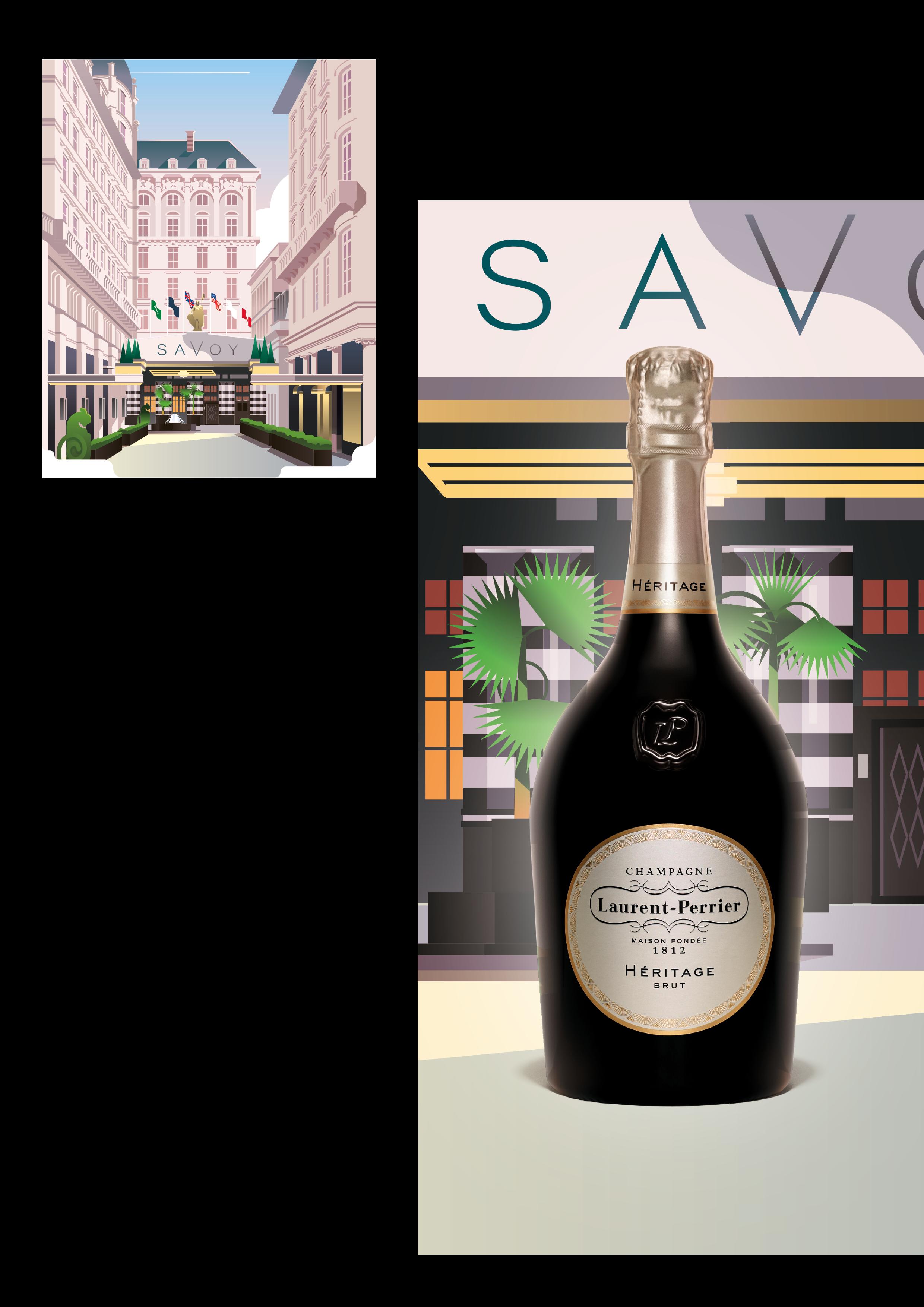


Rinse Natural Wine has just opened in the heart of Leeds. This is the third shop for Gemma and Elis Williams who own Fika North and Bottle Chop, both in Headingley.
“We didn’t want to create a chain because the core of what we do is indie,” says Gemma. “So although Rinse has the same offering that we have at Bottle Chop, we wanted to give it a bit of a different identity.”
The new name pays homage to the previous long-term tenant, Blue Rinse Vintage, which has relocated to premises over the road.
The couple opened their coffee shop, Fika North, in 2019 and diversified into wine two years later with Bottle Chop.
“Headingley is probably one of the most affluent suburbs of Leeds and the demographic is really interesting,” says Gemma. “We have customers of all ages: students, people who work at the university, doctors, all of whom are just looking for quality. People who have spent time in Spain, France, Italy, all of these lovely places which serve gorgeous food and gorgeous wine. That’s what they’re interested in and that’s what we deliver.”
The business works exclusively with natural wines which are sourced from suppliers including Beattie & Roberts, Under the Bonnet Wines and Otros Vinos.
“We do cheese and charcuterie at both sites,” adds Gemma, “but we also do special small plates, maybe in relation to what it is that we’re pouring, or to a specific event. And now, because we are in the city centre at Rinse Natural Wine, we have the market. There’s the most amazing array of fresh fish, fresh veg, fresh meat, fresh everything less than 100 yards away.
“So we are going to use the market as a resource for daily or weekly changing specials. It’s exciting to have this

opportunity on our doorstep.”
Having worked as a designer for 20 years before moving into the hospitality industry, Gemma says that it’s the creative part of the job she enjoys the most. “Creating the spaces and environments and coming up
with the brands is what I really love.
“It helps that I have the most amazing team, some of whom have been with me the whole time. Because they’re so brilliant it allows me to be creative and build more things. I’m very lucky.”
Chester Beer & Wine in Handbridge has rebranded as Pickles. Owner Sam Jackson initially started trading in 2005 as Scatchards of Chester and renamed as Chester Beer & Wine after five years.
Jackson has now evolved her business, which moved from its original Hoole site in 2018, into a hybrid. She felt it was time for a complete rebrand having overseen an extension to include a bar.
“I wasn’t really a fan of the name for a long time,” she admits. “I used it because I wanted to sell online, and I was advised at the time that it’s best to have a name that said where you are and what you do, so that kind of nailed it. I wanted a cosy, fun name and ‘pickles’ is just a fab word.”
With no business partner to bounce ideas off, Jackson has found the services of a mentor to be invaluable.
“I felt like I was in a bit of a rut and I didn’t know how to get out of it,” she says. “I knew I needed to make changes, but I didn’t know how to.
“I’d met Jenny at a business network club and asked her about what I could do to increase revenue streams. She suggested that we met every week to talk through what I needed. She just went through pretty much every aspect of my business, from profit margins and wastage to accounting and job descriptions.
“I know about wine, I know my job, but you have to know about business as well. Jenny has experience in so many different industries, so there’s tons of stuff that she’s been helping me with like health and safety policies and staff rotas.”
Additional advice came from fellow wine merchant Julie Irvine-Mills at Vinomondo. “I remember Julie said to me, ‘just employ really nice people’. I’ve now got a superqualified bar manager and another lady who are both brilliant.
“I was also really lucky with my builder, Gary. I had to slash budgets. I had to have two lists – one of the ‘essentials’ and the other the ‘nice to have’ – but we opened as planned in time for the Easter weekend and we’ve had a cracking opening week.”
• The Leamington Wine Company ceased trading in April. The business was established by Anita Mannion in Leamington Spa 16 years ago. A statement posted on social media cites “inflated and unpredictable alcohol taxes, combined with the cost-of-living crisis” as reasons for the closure.
10 to 5
Joinusforourfirst DrinkPinkWednesday,exploringover250rosésfromaround Provenceandtheworld,fromdozensofproducersineverystyle:paleanddark, dryandfortified.
OrganisedbyElizabethGabayMW,leadingroséexpertandauthorof Rosé: UnderstandingthePinkWineRevolution,andBenBernheim,co-authorof Rosésof SouthernFrance.
Throughouttheday,takepartinfourin-depthmasterclassesandroundtables: masteringtheartofupsellingrosé,keyrosémarkettrends,roséwinemakingand regionaldifferences,andaglobalblindtastingchallenge.



Venue: The Castlefield Rooms, 18–20 Castle Street, Manchester M3 4LZ Contact: uk@wineaustralia.com • chris.stroud@nzwine.com
• 70 wines from 28 regions across Australia and New Zealand
• New releases and older vintages from iconic producers
• Pét-Nat, alternative varieties, minimal intervention wines and new wave styles
• Organic, biodynamic and sustainable champions
information and register here


Photographer Ashley Bingham captures the action at Big Penny Social in Walthamstow where this year's Wine Merchant Top 100 judges put nearly 1,000 wines through their paces.
The winning wines will be available to taste at the London Wine Fair. Read all about them – as well as the highly commended wines – in our July supplement.

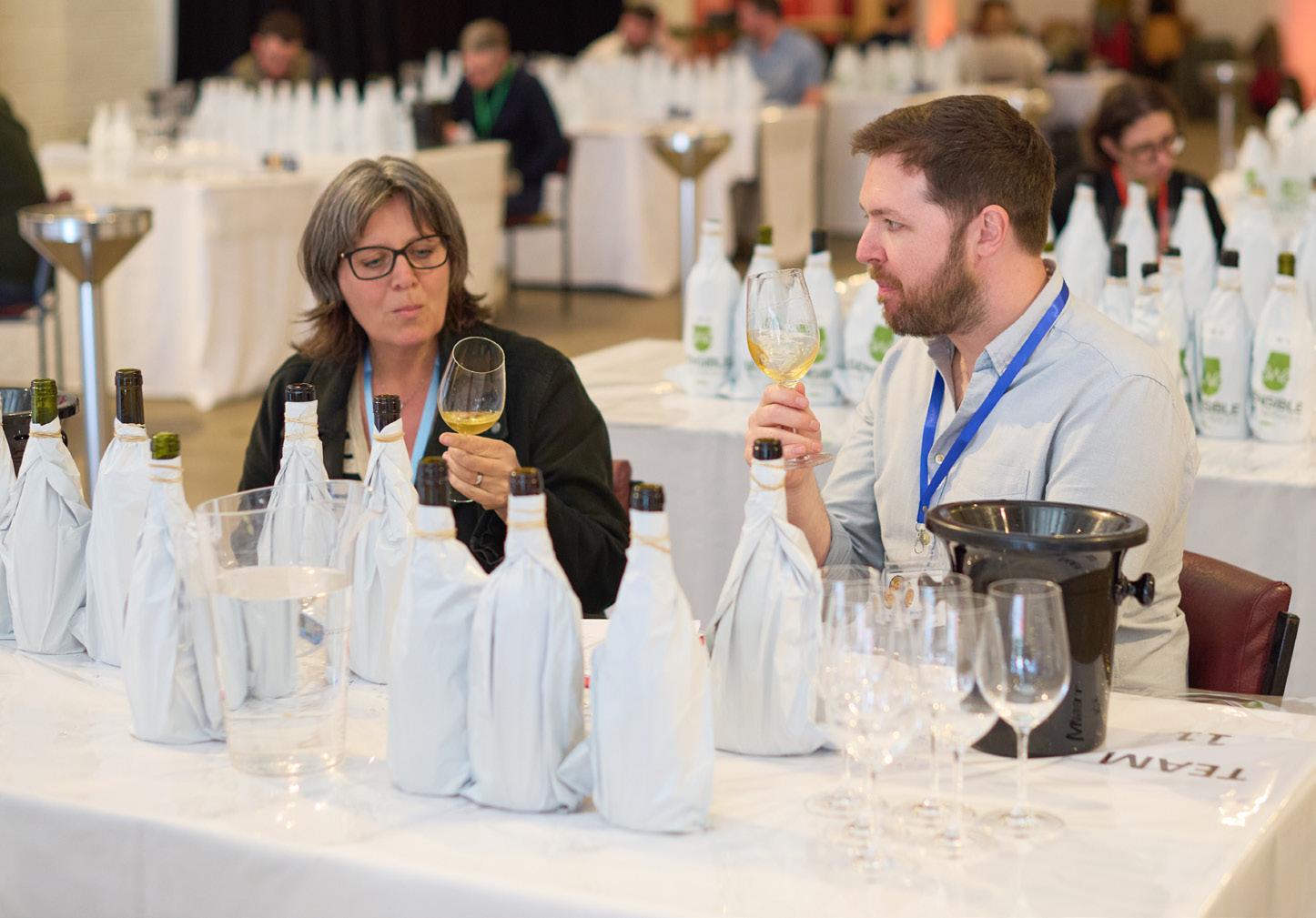


No fork-lift licence for me, but I do have the WSET Diploma, and access to Google

Alice has just started doing WSET Level 3. She won’t mind me saying that she is the kind of girlie swot that gets panicky if she is likely to get less than 99% in an exam. So, to reassure her that she already knew a fair bit, and before the course had begun, we looked at some past papers on the internet. That was fun. I would recommend it if you have a bit of time to spare. She passed them all with about 70%. The ones I tried, very selectively, gave me about 80%. I was proud of that but then I’ve been around
a while and it was multiple choice rather than essays. Looking at where I’d gone wrong, it was often that I had failed to read the question properly. Occasionally it was something about which I knew absolutely nothing.
That shocked me a bit until I looked at my WSET Higher Certificate hanging on the shop wall. It is 43 years old! A lot has changed. For example, back in 1982 Rías Baixas wasn’t a thing. It gained DO status in 1988. They still grew Albariño but not many people really knew and fewer really
cared. Even years later in 1989-90, when I did the Diploma, coverage of most bits of the new world just said the equivalent of “here be dragons”.
That probably explains why we don’t sell a lot of new world wines – I have never really understood them in depth. I can tell you the first AVA was for Wisconsin in 1980. The Santa Clara Valley was only being recognised as an AVA the year I started my Diploma. I didn’t know that then. I didn’t know that five minutes ago. Thanks to Wikipedia, knowledge is instant now. I still don’t know much detail about South Africa. If I really wanted to, I could find out at the click of a button. The same goes for Argentina and Chile. They appear to have different regions now, and lots of them. I’m vaguely aware of some bits of Australia and New Zealand. If I need to, I’ll Google them.
How much do you really need to know to run a wine shop, though? When I started in a little indie in Rutland, I knew absolutely nothing. My experience of wine didn’t extend much beyond Liebfraumilch and Chianti – which I pronounced with a Chee. I quickly realised that I didn’t have to know everything immediately. I just had to know more than the customer in front of me. Very quickly I had a fair understanding of the wines we sold and that was enough. If a customer appeared to know what he was talking about I would listen and then fact check, if I could, before repeating it. I then did the Higher Certificate and knew a little bit more. I also realised then that a lot of what customers had told me was bobbins.
When I did the WSET Diploma I did it over two years. That was lucky because the company I was working for then only lasted for three years. I didn’t really need that level of knowledge as I wasn’t the buyer and, to be honest, seldom had the opportunity to use my new expertise. The shop was, at the time, the biggest singlesite off-licence in Europe, possibly the world. Most of my day was spent making sure the right amount of stuff was in the right place. A fork-lift course would have been more practical.
Many years later, when I bought my shop, my knowledge was getting a bit rusty.




1. Punching down, the red winemaking process that breaks up the cap to extract more body and colour, is often referred to by which French term?
2. When were ISO wine glasses officially introduced? (a) 1974 (b) 1984 (c) 1994?
3. Where in Bordeaux is Petrus? (a) Pomerol (b) St-Emilion (c) Pauillac?
4. Which wine-themed visitor attraction near Borough Market in London ran from 1999 to 2015?
5. Which wine magazine is published by the same company as The New Statesman?
Answers on page 21




by Brett
















Frankie is a sales manager for Top Selection, covering the northern home counties, East Anglia and parts of the Midlands
I’m from Hungary and I sold a piece of land in the Teleki Grand Cru in Tokaj to fund my move to the UK 20 years ago. My family were farmers and when privatisation happened in Hungary we were claiming back lots of lands, but the infrastructure just wasn’t there. I was always a rebel and said to my parents: “You picked up the wrong baby, I was born in south London, I want to listen to The Specials”. I needed to come to see the Cockney Rejects, West Ham Utd and buy a pair of Dr Martens and other accessories to look the part. I arrived on a Tuesday and ran out of money by the Friday before I could do any of those things.
I went to military school and later got a job as a butler in a hotel. That’s when I met people who suggested I should be a sommelier.
My wife and I lived in Trinidad for a while and that’s where I started working for a well-respected wine merchant, Joseph Fernandes. He and my wife encouraged me to do my WSET.
I joined Top Selection in 2019. I’d had my own wine shop in St Albans, ThirtyNine 10. Top Selection were one of my main suppliers. I loved their portfolio and the company’s founder, Akos, is a fellow Hungarian and role model for many Hungarians in the UK trade. So when the shop closed I jumped at the opportunity to work with Top Selection. Being a poacherturned-gamekeeper gives me a great understanding of my customers and their challenges. I work hard to give them the wines and service that adds genuine value to their businesses.
I love my job because I travel to all these beautiful places in the UK. I see historical buildings and churches and I visit market towns where I meet brilliant people who share our love for the wine and for history.
Top of my list for the independents right now is Ulmus. It’s our own brand of wines made by some of the best boutique winemakers in the world. The Ulmus Bull’s Blood from Hungary is top notch. It’s made by János György in Eger and it’s really exciting to be able to offer something to the indies that is totally unique, from a famous winemaker with a story to tell.

younger generation.
The second wine from Szepsy is a late harvest Tokaji: Cuvée Anastasia. The grapes are harvested from the Nyúlászó Grand Cru vineyard and the majority of the blend is Sárga Muskotály. It is beautifully floral and dances on your palate. You feel the weight but you don’t feel the sugar content – it is the most amazing wine.
I took a group of retailers and sommeliers to Szepsy and I’d booked some accommodation for us all in the town. I was talking to the owner when his father in-law walked in dressed up as a medieval knight. He convinced us all to go with him to the castle to the medieval festival. He drove us up a really steep, cobbled hill. We were flying around in the back of this minibus, and then the madness began. One participant in the sword fighting started taking it personally, then another man almost got shot by an arrow. It started to feel like we were in Fear and Loathing in Las Vegas.

As a Hungarian from Tokaj, I am really proud to represent two projects from the Szepsy family. The first is Hun, a dry Furmint made by the 18th generation, István Szepsy. The wine is made from the younger vines and it just has partial malolactic ageing. It’s crisp and fresh, a really energetic Furmint in a beautifully designed bottle that offers an alternative to a
I’m doing an English course at my local college and writing a presentation about the legend of Tokaji Aszú. We are so proud that it was the drink of European royalty, musicians, composers, artists and poets. I probably inherited this love of history from my uncle. He is a very well-known historian who discovered the first written record of botritised berries in Tokaj.
I’m still into the punk rock scene and I go to see bands like GBH and Madball. I also like dirt bikes, so if anyone has a few speedway tickets … Feature sponsored by Top Selection
For
0845 410 3255

Libby is Taurus’s head of tasting events and digital marketing, a role that allows her attention to detail and organisational skills to shine.
“Libby started with us in the autumn of 2024,” says managing director Rupert Pritchett. “She’d graduated from St Andrews where she ran events for the university wine society and worked at Luvians.
“Her genuine enthusiasm for learning about wine has made her an instant hit with customers and other team members. Equally her studious nature: Libby is possibly the only person in the UK wine trade who is learning Persian, as alongside her work here and doing WSET Level 3 she is remote studying for an MLitt in Iranian Studies. That attention to detail has been ideal when planning our tastings and dinners.
“She has a natural affinity with Australian and English wines and so has been giving input to our selections for both. Her Greek heritage has also made her keen to start building up our Greek selection.”
Libby grew up in Sydney and moved to Surrey in her late teens. “My first introduction to wine was working at Albury vineyard, helping out over the summers and weekends with tours and tastings,” she says. “Wine wasn’t something we grew up with, so this was an exciting and new thing to throw myself into and it was quite an accelerated process.
“While at uni, I worked at Luvians and they were all about sending you on tastings and opening things in the shop. I remember my first day and they let me choose any bottle from the shelf and everyone had a taste and discussed it. That was my introduction to whisky as well. It was great.”
An undergrad in Middle Eastern Studies and international relations, Libby has an interest in political history, something she finds can lead inextricably to wine. “Recently we had a Chateau Musar event at Taurus and hearing some of the stories about it … the historical and political connection with the winemaking is so interesting. We’re doing a sake event next month, so it will be a continuation of different cultural storytelling.”
In addition to her academic success, Libby has nerves of steel, as demonstrated by her old hobby of rowing for her college team over a great white shark breeding ground.
Libby Frangopoulos Taurus Wines, Bramley, Surrey
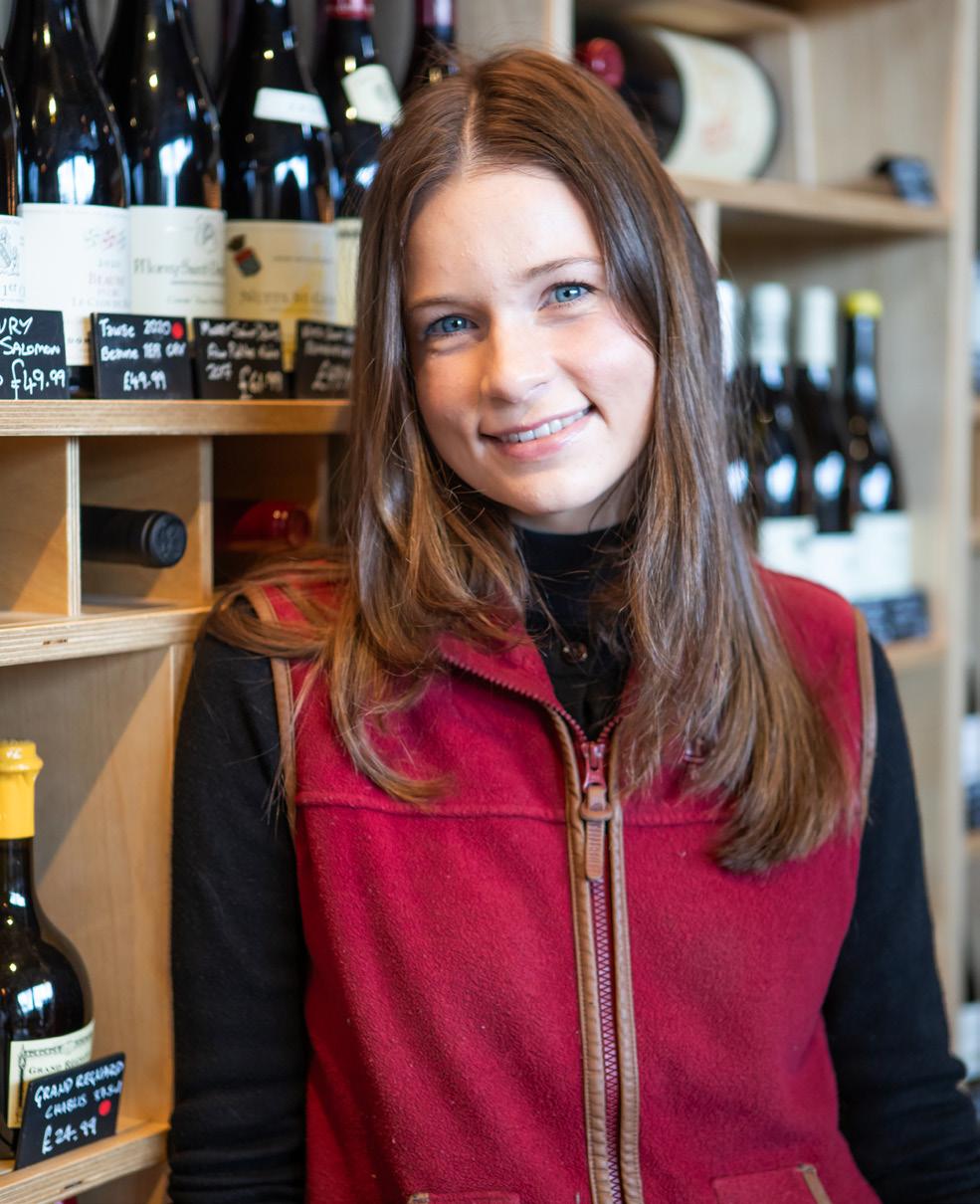
“We’d row out in Sydney Harbour and also out in Botany Bay,” she says. “We’d have to go at sunrise and sunset, which is the worst time for sharks and I’ve definitely seen a shark fin. I was always very scared, but I made sure never to fall in.
“I really enjoy being at Taurus,” Libby continues. “We always have an eclectic mix of people coming in and I really love preparing the events, giving thought to what will engage and resonate with people, putting together the wine lists and seeing how the caterers pair the food to match. Just seeing all those different components that go into a successful event is my favourite part of the job.”
Libby wins a bottle of Château La Fleur de Boüard 2018 courtesy of Mentzendorff
If you’d like to nominate a Rising Star, email claire@winemerchantmag.com


In a nutshell: Clickety-click, it’s Bright Idea number 66. Create your own grid system and call sheet with all things wine and find out how this enterprising Cheltenham merchant gets a full house.
Tell us more …
“We’ve done wine quizzes and wine bluffs, but I got the idea of wine bingo when I was with a group of girlfriends, and one of them told me about disco bingo. Whenever a song comes on and it’s on your card, you scratch it off. I thought that could easily be adapted for wine.
“We create our own card with a grid of columns. One column will be grape varieties, and the next column will be countries or regions or wine terms. The caller – and it’s usually me – will pull out tickets from our bucket, and if it’s something like ‘noble rot,’ we can explain what the term means while people are studiously marking it off their cards.”
So the bingo nights are educational as well?
“They are, but in a very fun, informal way. I would say that all of our wine tastings tend to be informal. We get a lot of youngsters who come in and they want to learn about wine, but they don’t want to be preached at and they don’t want to feel that they really don’t know anything. They want to come and enjoy themselves and gain a tiny bit of confidence and enjoyment from the evening.”
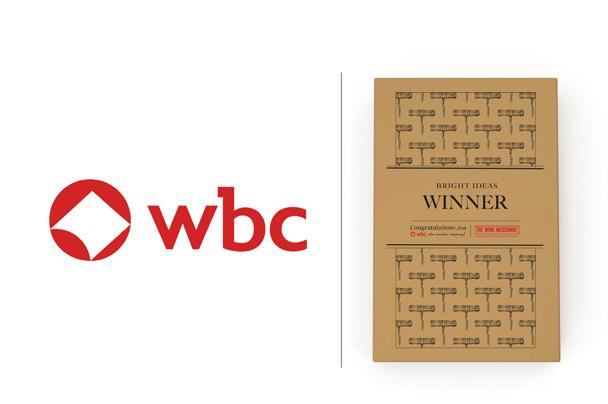
Do you need any special equipment?
“I use a microphone because the whole room needs to hear, and when you’ve got 40 people there, it does get noisy. We use an ice bucket to draw the cards from.
“We base it around a wine tasting and people will have a glass of fizz on arrival, followed by five wines during the evening. We don’t play bingo all night. We have a breather to allow people to chat in between and taste some wine. You don’t want it to go on too long because some people, once they’ve tasted a few wines, can miss one or two things.”
Typically how many people does this bring in?
“About 36 to 40. If it’s a nice, sunny evening I can get a few people outside, but our limit is 44. Depending on what wines


are, we charge roughly £30 per head and that includes the wine bingo, a tasting of six wines and sharing platters of cheese, charcuterie, salads, bread and crackers.”
How often do you run these events?
“Our bar and event side is the fun element of the business. We are 75% wholesale, and the rest is in-person shopping as well as online. The bar accounts for about 2% of business and because we don’t want to tread on the toes of the bars and restaurants we supply, we don’t want to be too shouty about doing events ourselves so we never do more than one ticketed event a month.
“It promotes the business and gets people to try new wines. A lot of people will buy drinks afterwards and buy wines to take home. It also gets new customers through our doors – and it gets chatter going on social media.”
Hope wins a WBC gift box containing some premium drinks and a box of chocolates.
Tell us about a bright idea that’s worked for you and you too could win a prize.
Email claire@winemerchantmag.com

Douglas Williamson
Juniper Wine Café & Drink Store, Dunfermline
Favourite wine on my list
I was reminded recently how much fun Life from Stone Sauvignon Blanc from Springfield Estate is. It’s nettley dry with a real zip.
Favourite wine and food match
I recently enjoyed some seared scallops with local black pudding. They paired beautifully with a bottle of Paul Pujol’s Prophet’s Rock Pinot Gris 2019. The mature fruit coped well with the spice and there was still enough cut to freshen the scallops.
Favourite wine trip
One of the earliest trips was in 1987 when I was one of the winners of the first Oddbins Australian promotion. Australian wine was still a new adventure, and they topped it off by throwing in a few days at the Adelaide Grand Prix.
Favourite wine trade person
Michael Saunders. I worked for him in the early days when Bibendum had a wine shop. He is a great leader who earns great loyalty from his team.
Favourite wine shop
Although they are possibly my most local competition, I would have to choose Luvians in Cupar, Fife. A great team with an impressive range – and vanilla ice cream too! Every shelf has something interesting on it. They have ploughed their own furrow for many years now.
Cafés and bistros in Paris are cheating customers by replacing quality wine with lower-cost alternatives when they serve by the glass, and tourists in particular are on the losing end of the swaps.
Few customers notice the difference when a premium Chablis at about €9 a glass is swapped for a Sauvignon costing about €5, an investigation by Le Parisien newspaper has found.
Two sommeliers detected switched wines, however, when they visited a series of bistros and brasseries while posing as English-speaking tourists for the newspaper. Waiters at restaurants and bars told the newspaper that the practice was widespread, especially in districts serving lots of tourists.
The Times, April 28

Australian wines are once again flowing freely into China, with exports topping the billion-dollar mark just one year after crippling tariffs were removed, according to Wine Australia’s latest Export Report.
In what could be called a grape comeback story, Australian wine exports surged 41% in value to $2.64bn and 6% in volume to 647m litres in the year ending March 2025, with mainland China gulping down 96m litres valued at $1.03bn.
AuManufacturing, April 29

Small vineyards are feeling the impact of new tax rules on alcohol which came into effect in February, as Majestic announced it has pulled some of its higher abv wines from smaller producers off its shelves.
John Colley, chief executive of Majestic, told The Telegraph that the retailer has axed a number of wines from small producers following the new tax rules which came into effect in February.
Majestic said that the change to its range impacts a small number of higher-abv wines.
Colley said it was a “sad thing” that the retailer was being squeezed as a result of reforms.
The Drinks Business, April 22
A study of nearly 50 European wines from several countries found many bottles contained traces of “forever chemical” compound TFA, or trifluoroacetic acid, said non-profit group Pesticide Action Network.
While levels varied, the group said findings were “a clear wake-up call for the EU” amid growing regulatory scrutiny of TFA’s presence in the wider environment and food chain.
TFA is formed through the breakdown of other forever chemicals known as PFAs.
Sources are thought to include some pesticides, as well as F-gases, which are often used in refrigeration and air conditioning. Decanter, April 25
Global glass bottle manufacturer O-I has announced it will cut 320 jobs in France in order, it says, to remain competitive.
The company says the move is due the downturn in the global wine market and to the increased competition it’s experiencing in the industry.
The company – which has a presence across wine regions worldwide – currently employs 2,200 people in France alone. The layoffs – which, O-I said, would not be finalised until the end of the year – would represent a workforce loss of 15%.
Wine-searcher, April 15
A dancer in Cyprus may have broken a Guinness World Record by balancing 468 wine glasses on his head while dancing.
Dinos Kkantis performed a traditional routine known as the Dance of the Glasses at an Easter Tuesday event in Aradippou, Kkantis, which involved an increasing number of trays of glasses being placed on his head while he danced.
UPI, April 24
Answers to questions on page 14
1. Pigeage 2. (a) 1974
3. (a) Pomerol 4. Vinopolis 5. The World of Fine Wine
Apologies: The most widely planted grape variety in Hawke’s Bay is Chardonnay, not Sauvignon Blanc, as we mistakenly printed in our April quiz.
Are you reducing the number of higher-abv



�No. We are more aware of the alcohol level than before, which is natural considering the way duty has gone. But we will continue to focus on the quality of the wine as the major consideration, and how well priced it is for that quality. When you taste wines that have been purposely produced at a lower alcohol level, there is usually something missing and it’s not as good. Selling great wine is what we are about.”
Sara Bangert
The General Wine Company, Liphook
�Any changes to our range in relation to abv levels would be a reaction to changes in customer purchasing. We have, over the last year, seen more awareness among our customers for lower abv wines, but there is still plenty of demand for the higher level. If customers did start to move away from the higher abv wines due to the abv level or the higher price, then we would react to this as demands changed.”
Debbie Buckley
Noble Green Wines, south west London




�I won’t be making any changes as a result of the new duty because I don’t deal with mass markets, I deal with people who are interested in wine. I came across a Chilean wine recently which had reduced its abv in order to reduce the taxes and it was an absolute shadow of its former self. As long as the alcohol is part of the flavour, like oak, it shouldn’t be excluded. I’m selling real wine and I don’t want to interfere with its integrity.”
Tom Innes H Champagne winner H Fingal-Rock, Monmouth
�We had already started reducing our amount of higher abv wines before the duty changes due to the demand for 12.5%-13% abv reds amongst our ageing demographic. The amarone has been sitting unloved on our shelves for some time.”
Richard Taylore
The Framlingham Wine Shop, Woodbridge, Suffolk
Champagne Gosset
The oldest wine house in Champagne: Äy 1584


We try to stick to a plan with tastings –and it works. For about three hours
Mike Tyson famously said of boxing strategy, “everybody has a plan until they get punched in the face”. In our business I reckon the equivalent would be, “everybody has a plan until they get hit in the palate by a portfolio tasting”.
When the tasting booklets arrive, I print them off and annotate them with coloured-highlighter prioritisations and ballpoint exhortations: “Taste!” “Must try!” “Compare all the Grüner Veltliners!”
There’s a lot to get through at these big events, and a clear plan of what to taste in which order is essential if I’m going to squeeze the maximum benefit out of the day. After all, it’ll be at least six months, and maybe a year, before I get another chance. What I buy and how much of that I manage to sell depends on having a PLAN. And it works. Until about three hours in. By 2pm I’m on Wine 50. I’ve proceeded from green-highlighted Musts to yellowhighlighted Maybes. The early focus on sparkling and white has moved through rosé and orange and I’ve started on reds. And this is where my palate gets hit and starts reeling. The plan’s not forgotten entirely, but it doesn’t seem to be guiding me so steadfastly anymore. Two tables

away there’s a range of Chiantis that I’ve earmarked to review for my Italian caffè customer. But in between me and them there’s a new producer from Priorat with funky labels and, I’m told, refreshingly low alcohol levels of only 14.5%. I might as well try them while I’m here … And before I know it, I’m deep in Barossa, Barolo and – heaven help me –port. About 3pm a realisation hits: I’m still sucking wine into my mouth and spitting it out, but my palate’s been Tysoned. It’s time to lay down my ISO glass and leave. And come back to collect my coat from the cloakroom. And leave again.
The following weeks constitute phase two of the portfolio tasting process. All the notes from all the tastings are pored over and collated: the best of this, the weakest of that, the best value of the other. This period highlights embarrassingly the inadequacy of my tasting notes, especially those from Wine 50 onwards, when my ability to write clearly and in detail diminished in tandem with my divergence from the PLAN. Hence the need to retaste all the promising discoveries from the tasting and also the few that might be promising if I could make out what I meant when I scribbled: “Lemon … Bio. Like that one in Pa. Grume??? Maybe.”
badly written Scots – grue, for disgust. Or it might be Wine 70 gibberish!
I suppose I could ask our suppliers to send sample bottles. But then, if I like the wine and want to propose it to one of our restaurant customers, I’d have to beg for another bottle to give them to try. Better just to buy six. Posting a case of samples to Orkney, separate from a pallet order, is offputtingly expensive, and there’s no chance of a sales rep dropping off a few extra bottles: we’re over 300 miles and a ferry ride from our nearest reps.
Eventually, in early April, we hold our own mini-portfolio tastings with our more interested restaurant customers. That is, those who want to taste and talk about the wines we’re proposing, as opposed to those who say: “You know about wine: you decide.” The latter response always makes me think: “You’d know at least a little about wine if you’d sit down and taste what we’re supplying to you.”
My two senior staff and I, all of us having been to tastings in different combinations of solo and duo, apply ourselves to respond to the wines each other has put forward, and to contribute to the larger conversation. Now it’s our turn to be relatively sober and circumspect in our behaviour. It’s the restaurant owners and managers who get over-excited at all these new wines – as we did in London and Edinburgh a month before. Luckily for them, we tend to present only 15 or 20 new wines for them to try each season, so they don’t struggle quite so much to stick to the PLAN.
A realisation hits: my palate’s been Tysoned
Bio might be short for biodynamic. Or just French for organic. Pa might be Paris. Or Pennsylvania. Grume might be badly written French – agrume, for citrus – or
By the middle of April everything is decided and agreed, and we launch into another busy summer season with everyone’s list refreshed and ready to go. Except for one. There’s always one. One restaurateur who goes suspiciously quiet after the tasting, despite having been especially opinionated during it. One who doesn’t reply to emails for weeks, and is infuriatingly evasive on the phone. Until, a day before our deadline for ordering Easter stock, we get a voicemail: “You know about wine: you decide.”
Duncan McLean is proprietor of Kirkness & Gorie, Kirkwall

The Alsace Wines trade campaign is an exciting opportunity to embrace the current strong – and increasing – demand for wines from one of France’s most fascinating regions.
The UK is now the fourth most important export market for all Alsace wines: a reflection of both the wines’ quality and diversity, as well as the impact of marketing efforts. The wines are particularly beloved by independent merchants – and their knowledgeable customers.
This year, Alsace Wines is offering 10 indies the chance to boost their Alsatian sales with an innovative promotion.
Each approved participating merchant will be awarded £300, allowing them to put in place a promotional strategy that best suits their customer base and business model. Retailers are free to list any AOC Alsace wines to best complement their broader range.
To be considered for the £300 bursary, you must:
• Have very few, or no Alsace wines currently on your shelves, and be keen to develop the range.
• Commit to providing full details, along with photographic evidence, of the new Alsace wines in store.
• Provide evidence of any promotional activity that takes place, such as social media posts, window displays, in-store tastings – the more the merrier.
apply for your bursary today
If you can fulfil the criteria opposite, you can apply for your £300 bursary straight away.
Email charlotte@winemerchantmag.com with your full details including business name and address.
You must have a bricks-and-mortar shop in the UK to be eligible. The final decision on the 10 bursaries will be taken by Alsace Wines, based on information submitted by participating merchants. Approved merchants will be contacted to say they have qualifed for the bursary. Money will be transferred once the promotion is complete, and after a report has been sent decribing how it went.
#DrinkAlsace Instagram: @AlsaceWinesOfficial
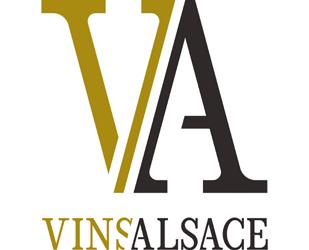
Alsace has an impressive number of family-owned estates, many of which have been making wine for several generations. As the locals are fond of saying, “there is a sense of responsibility for the next generation”. The vine growers of Alsace regard themselves as stewards of the land.
Organic and biodynamic viticulture lies at the core of this guardianship, with 30% of Alsace vineyards being certified organic, including 7% which have biodynamic accreditation.
The Vosges mountains are the geological and structural heart of Alsace. They serve as a barrier to rain and help harness 1,800 hours of sun per year.
The region’s turbulent geographical history has left an extraordinarily varied and complex range of terroirs. You will find all of the geological formations from the Palaeozoic to the Quaternary eras in Alsace.
The wines are the greatest storytellers of the terroir, with each soil type influencing what’s in the glass in its own way. Wines from high-altitude schist soils tend to be svelte and austere, while those with sandstone origins are livelier, with strong varietal expression. In the Vosges foothills, marly limestone yields full-bodied, well-structured and peppery wines, while pure limestone gives flavours of lemon and fine acidity.
As sommeliers and foodies can attest, the wines of Alsace have outstanding versatility for matching with food.
As Portuguese sommelier Nuno Pereira told Squaremeal: “Alsace wine brings an incredible range of pairing options. From light starters using the freshness of Sylvaner, to the option of fish or meat using the richness of a Riesling or Pinot Gris. And even the Vendange Tardive can be an experience for a customer when paired with fruit-based desserts. Not to forget the versatility of Gewurztraminer for a spicier dish or for a customer who has a sweeter preference of wine.”
Remember too that Alsace has some of the best cheese and wine pairing options. Cheeses such as Blue Stilton or Stinking Bishop taste their absolute best with a glass of AOC Gewurztraminer in hand.

While they represent just 3% of the total wine production in Alsace, the region’s Grands Crus wines are right at home with the great fine wines of the world.
These most special vineyards bask in the sunshine, on the slopes of the Vosges. With 51 Grands Crus cited, the diversity of soils is clear. Each wine tells the story of its individual terroir, through its structure and aromatic profile.
Though every wine is unique, there are qualities that all AOC Alsace Grands Crus wines share: elegance, with the structure to age for many years. Saline and mineral, the wines have impressive tension, breadth of flavour and power.
In addition to the 51 Grands Crus there are two additional labels to look out for, especially for those with a sweet tooth. Vendanges Tardives and Sélection de Grains Nobles are sweet, opulent, powerful wines made from grapes affected by noble rot.

Indies are loyal enthusiasts of Alsace wines, which they appreciate for their distinctive style, value and individuality.
It’s often suggested that Alsace is a secret that the trade is happy to keep to itself. But the wines are so consumer-friendly that, with a little promotional effort and perhaps some expert hand-selling, the category can be commercially successful for indies.
Participating in this trade campaign is a great way to re-engage with the region and share the widespread love for the wines with customers.
Eric Zwiebel MS, one of the UK's leading sommeliers, told The World of Fine Wine in 2024: “The big advantage is value for money, whether it’s crémant, still wines from Alsace regional appellation (with the name of the grape variety on the label) or grands crus (with the terroir on the label).
“The quality of the wines has never been as good as it is now, with so much diversity of style from the different white grapes but also with many producers now making macerated or orange styles. The Pinot Noir, too, can be rosé, a light fruity red, or a more oaky serious style.”
So sign up, secure your £300, and enjoy the task of selecting thrilling new AOC Alsace wines to add to your range.
Remember: the bursary will be paid retrospectively to qualifying merchants, once you've sent in a report saying how your promotion went.
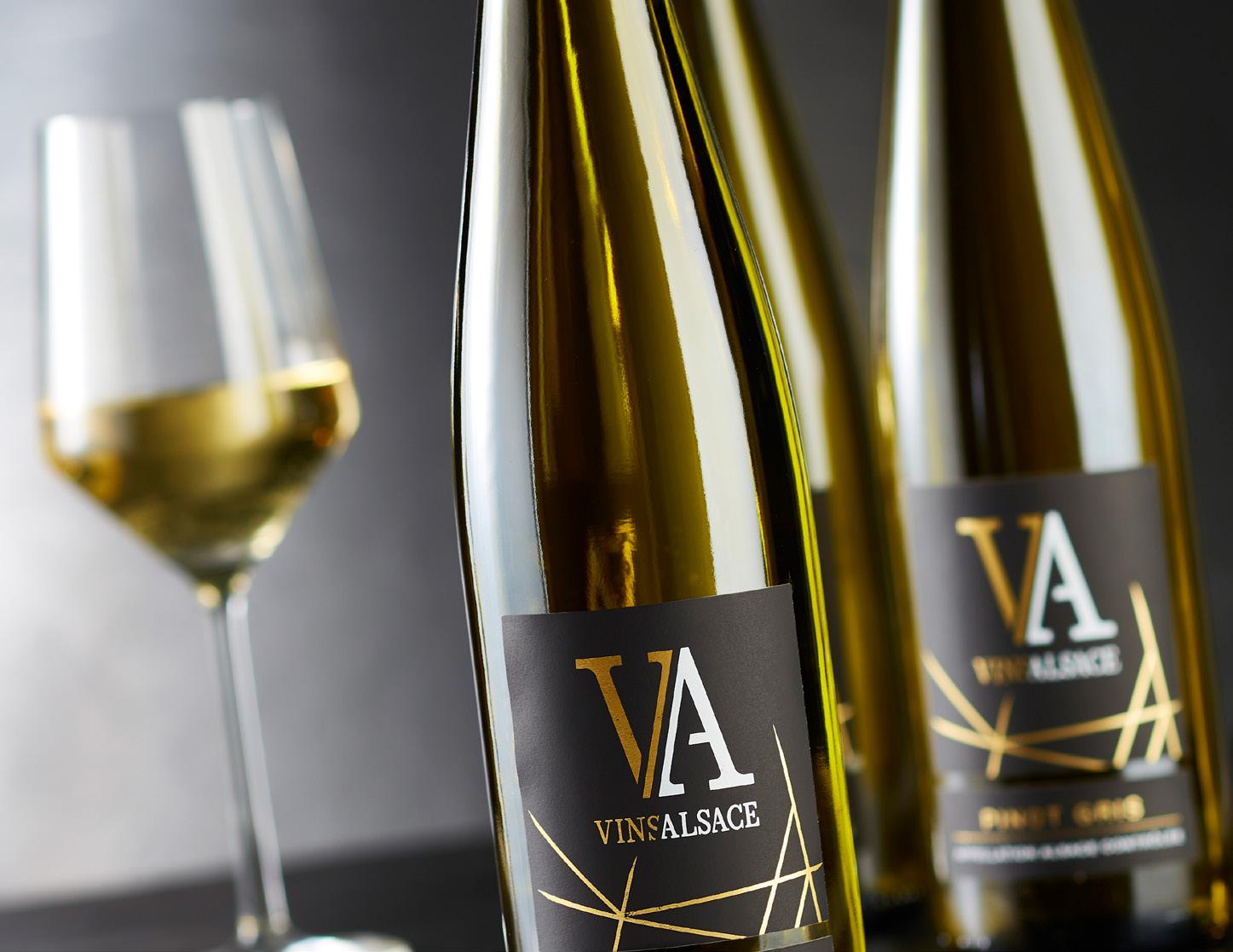
White wines dominate Alsace wine production, representing 88% of the still wines made. It is important to note that the region also produces fine reds from Pinot Noir, delicious AOC Crémant d’Alsace sparkling wine, and unimaginably complex sweet wines too.
On the shelf, the wines present like a dream for indies, with grape varieties named on the labels.
Here’s a whirlwind tour of the most widely planted varieties in Alsace and the roles they play.
AOC Gewurztraminer. Regions around the world envy Alsace’s exotic and exuberant varietal. The wines can be tropical, sometimes spicy and maybe even floral – but always exciting, and a truly fantastic option to pair with food. The sweet wines are without parallel.
AOC Pinot Blanc. Always charming, in the hands of Alsace winemakers, Pinot Blanc yields fragrant, stone fruit-flavoured wines that are supple and deliciously moreish.
AOC Pinot Gris. Locals recommend that Pinot Gris be allowed a little time in the glass, to let its autumnal stone fruit, ginger spice and smoky notes emerge. The variety gives wines with super balance and a generous mouth feel.
AOC Riesling. Riesling can reach world-beating heights in Alsace. Always fine and linear, flavours range from citrus to spice, floral to orchard fruit. The more complex wines show great minerality.
AOC Pinot Noir. Don’t miss Pinot Noir from Alsace. Delicate, with bundles of vibrant summer berry fruit, it’s very much a wine style being sought out by consumers right now. Pinot Noir thrives in Alsace, where it is free to show off its terroir-expressing credentials.
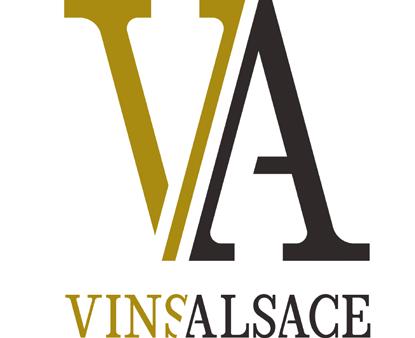

Daniel Grigg’s wine journey started in the unlikely location of the wine aisle of Tesco in Hook, Hampshire.
“I was 18 and didn’t really know what I was looking at,” he recalls. “I picked a bottle where I liked the look of the label and price. It was a Banrock Station Shiraz at £5.99, which was quite a lot 20 years ago. Aussie Shiraz was my gateway drug.”
He took his WSET Level 1 a year later and the Level 2 the following year. Now, via stints in retail with Spirited Wines, Majestic and Wickham Vineyards, he’s managing director of Museum
Wines, in the village of Tarrant Hinton, about five miles north east of Blandford Forum in Dorset.
Museum’s next-door neighbour on the site of a former dairy farm is The Labrador Co, which specialises in all manner of Lab-related merchandise. “Foot stools, armchairs, teapots, cups, curtains: anything you can get a Labrador print on, they have,” notes Grigg.
Museum is owned at long distance by Alex Boon, who now lives in South Africa. Greg Sherwood MW joined the team in 2022 after 22 years of building London wine merchant Handford Wines’s unrivalled reputation in selling South African wines.
Unrivalled until Museum came along, that is, and bagged Decanter’s top South African wine merchant award for three years on the bounce.
Many of the South African wines Museum sells are directly imported on an agency basis.
“I love the bravery and entrepreneurial spirit of South Africans, to work with grapes like Cinsault, Colombard, Palomino and so on, which traditionally don’t or didn’t have much commercial demand,” says Grigg.
“They do it because they’re true winemakers, not robots trying to pump out the next 100-pointer manufactured to the taste of whichever critic is flavour of the moment.”
The wine shop is based in a stylish, modern, barnlike retail space that was purpose-built for Museum, which originally operated out of the car park of one of two pubs run by Boon. The other, the Museum Arms, gave the wine business its name.
“People would have lunch and buy a case of the claret they’d had with it,” says Grigg. “Then they’d add some Burgundy and Champagne and suddenly lunch had gone from 90 quid to £450 because they’d bought six bottles of wine.
“It was obvious there was demand for a wine merchant. It’s a very affluent area: lots of people who’ve done well in the City retire here. Or, if they’re still working in the City, they have a second home.”
“It was obvious there was demand
for a wine merchant. It’s a very affluent area”
Has the business always specialised in South Africa?
My first trip to South Africa was in 2016 and that was when we made the decision to focus on it and work with farms exclusively, acting as their agents.
Alex is married to a South African and has lived
there since 2020, and he lived there in the 1990s as well, so there’s a connection.
We identified it as a bit of a gap in the market where there was unfilled demand. Seckford has a very good portfolio but it’s more the old-school brands, and there wasn’t so much of people doing the new wave, apart from a little bit with Swig. We found producers to work with who weren’t represented in the UK who we thought should be, and we’re now at around 25 producers, all but one of which are exclusive.
And you wholesale outside of the agency producers as well?
We don’t really distinguish agency from wholesale. We use predominantly Alliance for Prosecco, Malbec, Sauvignon, Pinot Grigio … pub wine. Our biggest volume from Alliance is from a Romanian producer. We probably could go and find our own and bring in a pallet, but because Alliance are so big and have such buying power it’s convenient being able to order 300 bottles one month, or 120 another; it comes as part of a mixed pallet and arrives the next day. There’s no benefit to doing it ourselves for wines we’re not particularly passionate about. We focus our agencies on wines that we are passionate about it, rather than trying to source wines to save 20p or 30p a bottle.
What’s the turnover split like?
About 40%-50% is wholesale and then retail is split between my private clients, Greg’s private clients, bricks and mortar through the door, and
“Visitors to Cape farms can order wines from us at their cellar doors. We raise an invoice and it gets delivered once they get home”
then ecommerce, which is our website and Vivino –and we’ve now added business from South African tasting rooms.
What’s that about?
We’ve started an initiative with the farms we represent, so that visitors from the UK can order at their cellar doors. We raise an invoice and it gets delivered once they get home. It’s been a long time setting it up. The order forms have a QR code on them and the idea is they scan the code and it goes to that winery’s section on our website and they place the order there. But very often they don’t and we’re trying to figure out why. It may be older customers who don’t understand how QR codes work, but you’d be amazed at how many people just fill in the form, write out their credit card details and hand it to someone else who then sends it to us.
What is Greg Sherwood’s involvement in the business?
He’s the fine wine director, which has an element of buying about it. After 22 years at Handford he had relationships and allocations that came with him. We already had an allocation of Sassicaia but we got a bit more. But there were things like Raats MR de Compostella where we were offered much more access than we would ever have had before because he had a client base that he brought with him.
Grigg identified a “gap in the market” for specialist Cape wines

But you were already focusing on South Africa before he joined.
We’d already won the Decanter award three times, but he had customers who like buying South African wine for over 22 years and they’re now being introduced to our portfolio as a captive audience.
What is it about South Africa that makes it so appealing?
South African wine was probably the one I had least interest in when I started in the industry. I think going back around 15 years it had whites that were a bit homogenous. They were often the cheapest on a pub wine list or on the bottom shelf in retail.
I describe Chenin Blanc as having done a reverse New Zealand Sauvignon, which in the 1990s could be quite scarce. A wine merchant might get 36 bottles of Cloudy Bay but now with New Zealand Sauvignon it’s turn the tap on, turn the tap off. It’s lost that exclusivity, whereas 15 or 20 years ago South African Chenin was not very well regarded,
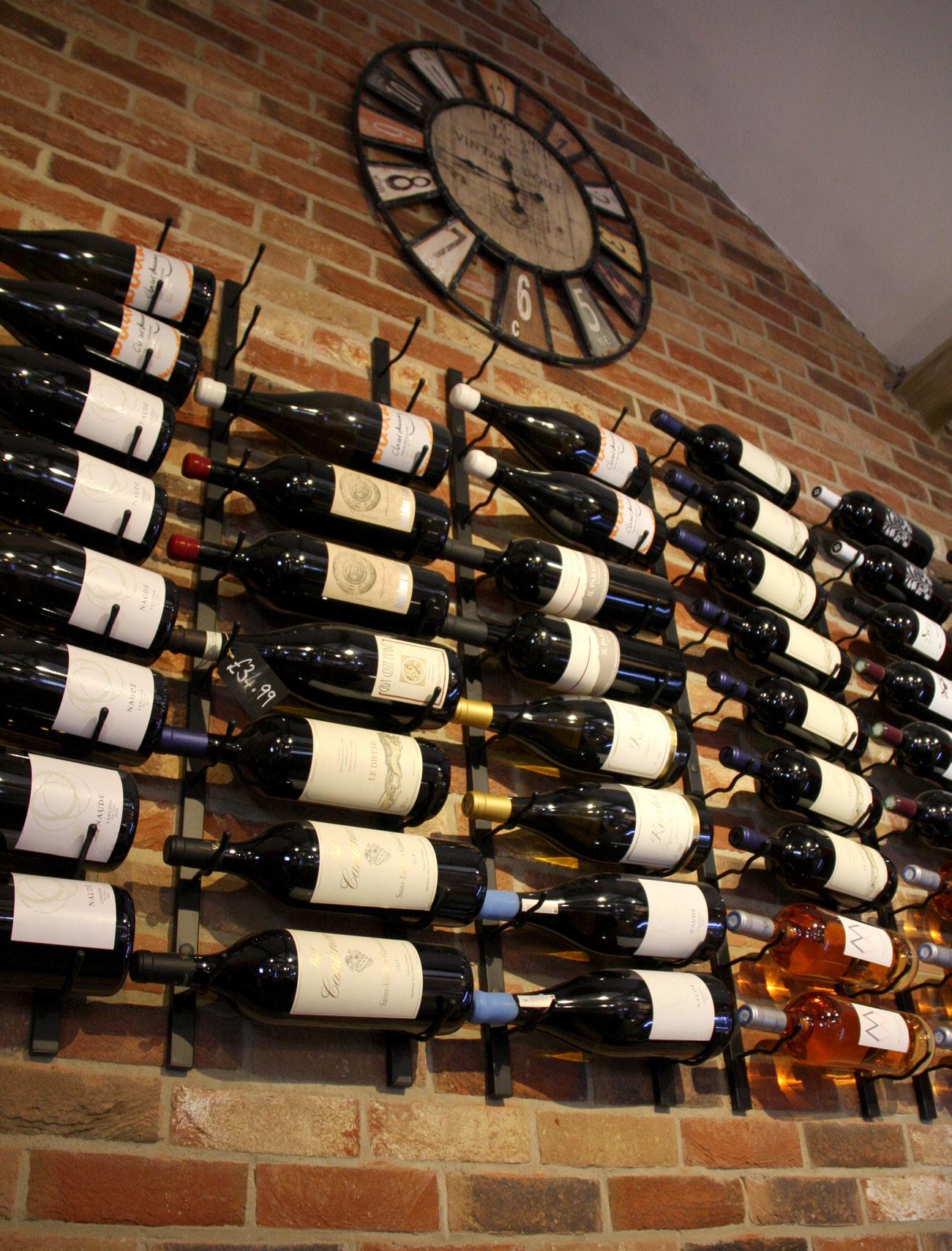
a bit nothingy, almost Pinot Grigio-y. There were exceptions, like Ken Forrester’s FMC, but there wasn’t the variety of different styles we have in the South African section now.
What sort of variety do you offer now?
There a are a lot of options from South Africa for a customer base who wants something like Burgundy in style and alcohol. One of our best sellers is Axle, a Chenin Blanc from Natte Valleij, which is £24.98 and has a fantastic story. Alex Milner is a Cinsault specialist. His wife said: “Alex, as much as I love your Cinsaults, we do live in South Africa where it’s very hot and it would be lovely to have a white wine in the range”. So, he made one to her brief, from old bush vines in Darling, certified 1985. He made 360 bottles of the 2018 vintage and said to me that even with the wind behind her she was never going to drink 360 bottles a year, so would we take half. He’s scaled up production but we’ve always taken about half.
How would you describe its style to a customer?
It’s a very pure style, 13% alcohol, with some time in old seasoned barrels on its lees. It’s a bit of a Burgundy botherer. We have lots of lapsed Burgundy customers. When I first started here our cheapest Montrachet was £29.99 and now the cheapest one is £95.50. That was only 10 years ago. People don’t want to spend three times what they used to pay for something.
Similarly, with Gevrey and Nuits-Saint-Georges we probably would have been half the current price 10 years ago. We do have customers who we’ve got into South African Cinsault as an alternative.
There are also some good Burgundian styles of Chardonnay from South Africa that aren’t as full blown as American. All of our American Chardonnays are £75 and above and 14.5% alcohol, whereas South Africa seems to have been one of the few new world countries that’s been able to grasp heat management and produce wines at 11%.
Lokaia’s Call of the Void is a Cabernet Franc that’s 10% abv, so it’s duty-defying. It makes a Sémillon, a Chardonnay and a Cabernet Franc, all in a single amphora, so production is only about 600 bottles.
Tell us more about your location.
Retail sales, in their various forms, make up about half of trade
It’s an old dairy farm. The site includes a business park with much less interesting businesses like accountants and architects. We have storage across the way, but it’s basically just flat pack packaging and WBC boxes. We’ve got a bond with EHD in Amesbury and that’s where all of our trade orders are delivered from. It means we can have a Dorset headquarters with rural rate relief but still deliver into London the next day as standard. Anywhere else in the country is 48 hours.
“We
have a Dorset headquarters with rural rate relief but can still deliver into London the next day as standard”
The barn just across the way is going to be pulled down and converted into more units. The landlord has promised to try and get some more relevant businesses like a butcher or a cheesemonger, like a little farm shop hub, but whether that will happen we don’t know. But that was always the intention when this was built; it was going to be a one-stop shop for artisan fare.
What’s the competition like?
There are Majestics in Poole, Salisbury and Dorchester, which are all about 30-40 minutes away. For a lot of people, we’re much closer … and you can’t go into Majestic and buy half a case of Talbot 2016 or grand cru Chablis or Gaja Pieve
Santa Restituta Brunello or Kistler Russian River Pinot or Chardonnay. If you want to spend 120 quid on American wine here, you can, but we’ve got stuff that starts at £8.99, and a good range from Simonsig, which is all £9.99, so we do cater to every pocket and palate.
Is it a lonely existence out here on the farm or is there a steady stream of walk-in business?
There’s a pretty steady stream. More than you’d expect. There’s the convenience factor of being able to park right outside. It’s almost the Majestic model of plenty of parking and very little queue. And everyone’s got a Range Rover, so they just reverse up and open the boot. Some people will come and buy four weeks’ worth of wine and then “see you next month”. At Christmas someone might come in and spend £1,500 on 30 bottles, which on a high street you can’t do because very rarely can you park right outside.
You’ve a terrace at the front with some tables and chairs – and a pizza oven. What level is the hybrid element at?
When I started, we did a Friday evening bar scenario but invariably people would leave to go to the pub to eat. The answer seemed to be food. Initially we did food trucks but they were a bit unreliable. They’d either break down on the way, or forget, or not put it in their diary. You’d advertise that they were coming in and they wouldn’t turn up. So, we thought “we’ll build our own pizza oven”. It was a joint investment with the landlord. We did it every week through 2017, 2018, 2019. But then a farm shop 1.8 miles away had the bright idea of putting in their own pizza oven, but their wine was a lower-end offering. We stopped doing pizza and one night did lobster and chips, for £25, and found people were buying £45 bottles of sparkling rosé to have with it. We ended up with maybe half the number of people, but they were spending two or three times as much on wine. We’ve done burritos, curries … we did a fine dining pop-up restaurant when Alex was living in the UK. He was a chef in a former life, so he did most of the cooking. We turned the whole shop into a restaurant with 25 covers, pre-sold at £75 a head including wine – four courses with a wine match for each.
Has the cost-of-living crisis had an impact?
We’re doing very well with wealthy customers,
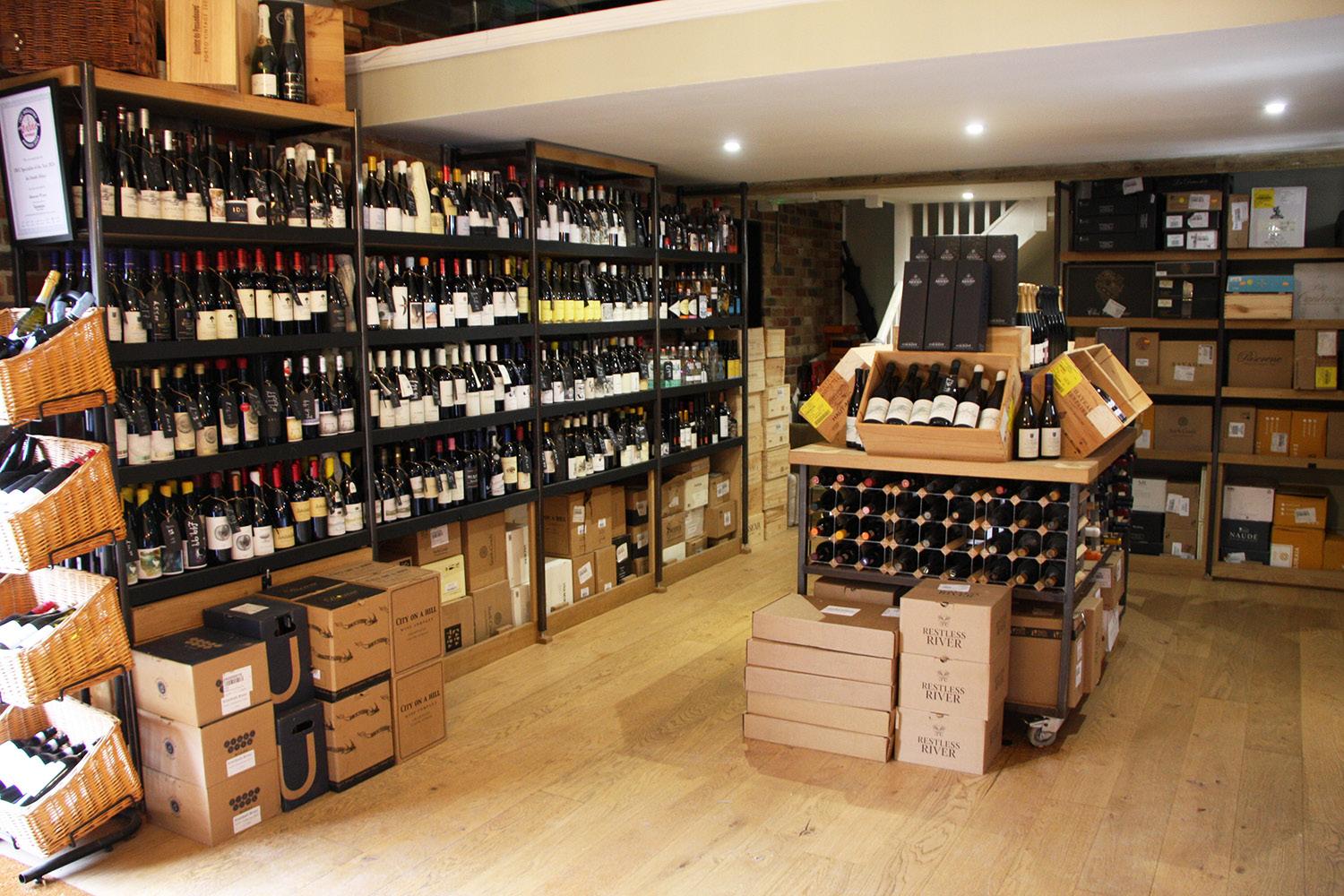
The store has a “steady stream” of walk-in trade despite its isolated location
“A customer bought a dozen Vega Sicilia Unico in January at £379 a bottle and spent another £1,000 the following week on Groth Cabernet”
who are still spending willy-nilly despite it. I had a customer who bought a dozen Vega Sicilia Unico in the middle of January at £379 a bottle, and spent another £1,000 the following week on Groth Cabernet.
If we are losing in any way, it’s the base of the aspirational middle class who used to have a budget of £500 a month for wine, but have seen their mortgage go up by the same amount. It’s not that they’re not coming in any more, but instead of buying 24 bottles they’re coming in on a Friday and buying two or three to get them through the weekend and cutting their cloth.
Even though we have wines at £8.99 and £9.99 we are a destination; you’ve got to come out of your way to get here. If you’re going to the supermarket to buy milk and toilet paper and you see a bottle of wine at £8.99 there’s got to be a real incentive to not buy that bottle and come here instead and make an extra trip.
How can you persuade them they should?
Every time you come here you get good service and a good experience – and it’s a fun place to be … giving them the level of service they wouldn’t get in a supermarket, or even in Majestic. I do go into Majestic every so often just to see what’s going on and I don’t think the level of service is what it was.
That’s what independents do best. Before they go on the shelf we try every wine to make sure they’re good enough. If we’ve got 12 Chenin Blancs with stylistic differences, we need to be able to tell people what those differences are. We have people come in and say they don’t know anything about wine. That’s why we’re here!

In early April, three members of the independent trade – Mark Bedford of Caviste in Hampshire, Kenny Vannan of Villeneuve Wines in Peebles and Neil Gladding of The Oxford Wine Company – joined a small group from the UK on a visit to one of France's most fascinating wine regions.
Graham Holter joined them


It’S aLwayS SUNNy heRe aND we have a NatURaL CONCeNtRatION IN OUR GRaPeS. we DON’t waNt mORe waRmth aND DRyNeSS IN OUR wINeS
Perpignan is being whipped by the Tramontane when we arrive. This north-westerly wind is expected in the early spring, but this year its violence has taken locals by surprise.
Roussillon nestles in an amphitheatre between the Pyrenees and the Mediterranean and is no stranger to gales: it has at least eight named winds, which blow for 100 days of the year. The Tramontane might be making nights noisy for the time being, but what’s ultimately causing more sleeplessness is the Sirocco, the warm Saharan wind that can scorch vine leaves and berries and which is becoming a more regular feature of Roussillon’s weather.
Drought is a huge issue for vignerons, as the official 2024 vintage report confirms: “Over the past five years, rainfall has been decreasing, from 530mm in 2020, down to 250mm in 2024. The effects of the last couple of years’ droughts are still being felt and, in areas such as the Aspres, Rivesaltes and Canet-en-Roussillon, some vines simply shut down.”
The net result was a 45% decrease in volumes on 2023. It’s estimated that 15% of the region’s vines were pulled out of the ground last year as landowners looked for less problematic ways to make money.
That’s enough of the bad news. If we’re looking for positives – and there are plenty – we could start by considering that Roussillon’s winds naturally reduce disease pressure. The sun which shines for 320 days of the year might be intensifying, but varieties such as Carignan and Macabeu are well adapted to hotter conditions, and are producing wonderful wines.
Our first visit is to Domaine DanjouBanessy in Espira de l’Agly, just north of Perpignan, which works with Dynamic Vines in the UK. Benoît Danjou’s 60-year-
old Mourvèdre and Grenache bush vines are hard to spot, surrounded as they are by mustard, beans and other green manure crops that will be ploughed up later that day to release valuable nitrogen, potassium and moisture into the black schist soil. This terroir imparts a smoky, spicy aroma.
One of the estate’s most intriguing wines is Clot Escounils, a massal selection of Grenaches Blanc, Gris and Noir, fermented in foudre and aged in old oak barrels for 18 months. Electric and mineral with a streak of aniseed, it’s almost like Roussillon’s answer to Chablis.
Benoît’s winemaking is based on gentle
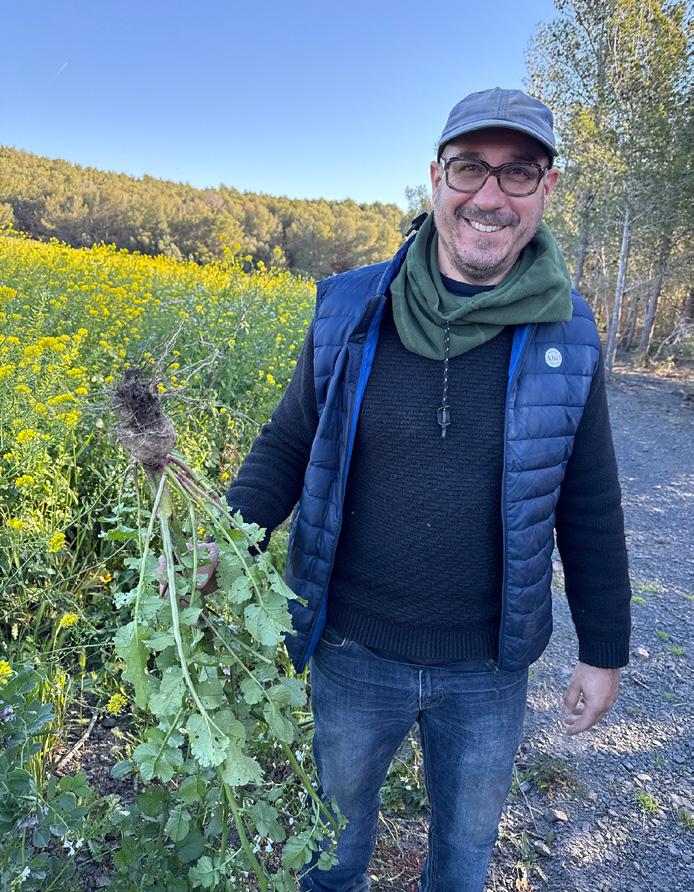
infusion. “It’s always sunny here and we have a natural concentration in our grapes,” he says. “We don’t want more warmth and dryness in our wines.” As Eric Aracil of Vins du Roussillon adds: “Sometimes people think of Roussillon as a place for heavy wines, but it’s really not the case. We have harmony and balance. I always say that 50% of terroir is human.”
We head to nearby Maury, stopping en route to get a sense of the garrigue: fennel, juniper, rosemary, thyme and even asparagus sprawl by the roadside. We’re greeted at Domaine La Toupie by
Jérôme Collas, who farms 12ha of scattered vineyards on his own, without even a tractor for company. Again, big extractions are out of favour here, with all fruit destemmed, and limited pumping over.
Sur 1 Fil Rouge, a Maury Sec, is a Grenache Noir, Mourvèdre and Syrah blend which has been particularly well received by critics. The 2022 is a confident wine, brimming with dark fruit character; the 2023 has a pronounced graphite aroma and suggestions of herbs. Although still 15% abv, it feels lighter, and is a good advertisement for an appellation that dates back only to 2011.
Next stop is Les Vignerons de Maury, one of 24 co-operatives that still thrive in Roussillon, and three in Maury itself. The 700ha of vines are farmed by 100 growers, mainly on calcareous schist soils. The presentation (and arguably the winemaking) is a world away from what was typical in a co-op a few decades ago; Mark Bedford is particularly taken by the entry-level Tribu range, whose labels feature the names of all the growers.
It’s here that we get a first proper taste of a rancio wine. These are a Roussillon speciality, made with old-vine grapes aged oxidatively for at least five years. The first year is typically spent in the full glare of the sun, in a glass demijohn or partially-filled barrel. As the wine evaporates, complex umami flavours develop.
Les Vignerons de Maury’s Tuilé Vieille Réserve 2011 is made entirely with Grenache Noir. We pick out rich soy sauce and bay leaf notes, maybe some juniper, as well as caramel and bitter orange. It’s easy to see why wines like this have a cult following.




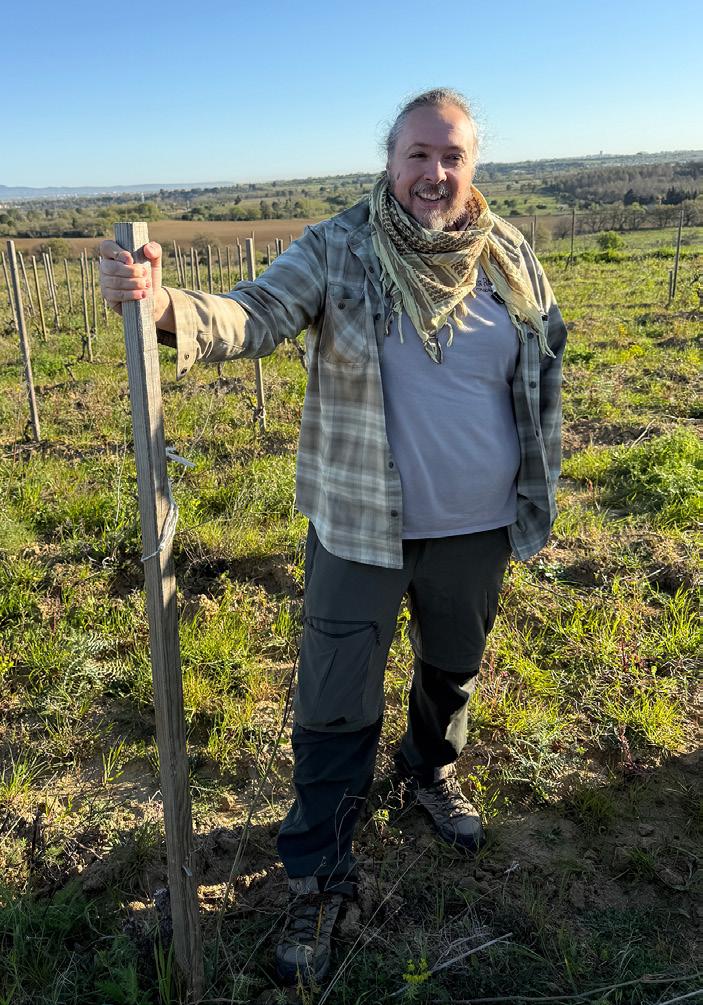





The day’s final visit is to Domaine Cazes in Rivesaltes, an estate dating back to 1895. Owner Lionel Lavail is proud that his was one of the first estates in France to embrace biodynamics. It’s still moving with the times, experimenting with robots and drones to work the soil and spray the vines.
Le Canon du Maréchal proves to be one of the most enjoyable rosés of the trip. Just as it says on the front label, it’s a SyrahMourvèdre blend, with bold red fruits and an appetising spiciness. It’s got a pale, commercial hue, but this is a serious wine that deserves food. Mark Bedford of Caviste is quick to make enquiries about magnums.
The morning starts in Aspres, at Mas Bécha, owned by Charles Perez since 2008. This organically-farmed 130ha estate, for which the Canigou mountain provides a dramatic backdrop, has a range of soil types including marble, sand, quartz and clay. To cope with the warming conditions, gobelet-trained vines have been planted on north-facing slopes, replacing those on south-facing plots. Grenache, in particular, appreciates this, while Mourvèdre achieves its best results on the estate’s higher ground. Syrah, it seems, is happy pretty much everywhere.
Patterns 2020 combines all three varieties. Aged in stainless steel to preserve fruit purity and freshness, it’s a beautifully balanced wine, full of mineral nuance as well as the brisk red fruit flavours for which Aspres is known.
Château de l’Ou, a 15-minute drive to the west of Bécha, is another organic estate, established by Philippe and Séverine Bourrier in 1998. The wines are imported by Hallgarten.
Philippe shows us his army of amphorae, which he believes give wines with more fruit character than he’d get with oak, and allow more oxygen exchange than he can achieve with stainless steel. We’re poured L’Ove 2016, a Grenache Gris that justifies his choice of vessel. Despite coming from a
year associated with low acidity, the wine is vibrant and floral, with some Rieslinglike petrol notes. It’s amazing how it has evolved.
Secret de Schistes Blanc 2022 is also made with Grenache Gris, but with half fermented in amphora and half in new oak. The barrel brings out the texture of the grape and contributes to a smoked almond note. It’s a powerful and complex wine that we probably taste far too quickly.
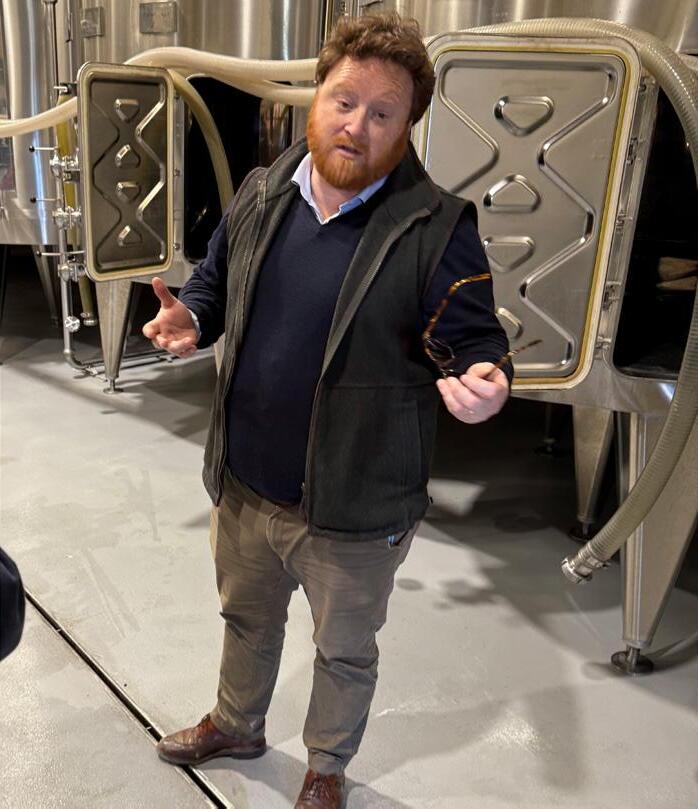
We hear that the owner of the next winery on itinerary, Château Corneilla, has Scottish connections – and on first impressions William Jonquères d’Oriola does have something of the Highlander about him. His mother may have been a Scot, but his father’s family have been making wine here for 27 generations, since 1485.
William took the reins in 2010 and scaled down the size of the estate to 80ha, focusing on plots that could express mountain terroir on one side, and Mediterranean influence on the other. He introduced carbon dioxide from the fermentation process to gently punch down the cap, which he feels has notably improved the wines.
Pur Sang – meaning “thoroughbred”, a nod to the family’s equestrian sporting achievements – is one of the highlights. A blend of Syrah, Grenache Noir, Carignan
and Mourvèdre, it spends eight months in large barrels. The 2022 is bursting with black fruit and has an attractive undercurrent of smoke and spice. The tannins are still squeezing, but this will be a special wine.
Our last winery visit is to Mas Baux, 3km from the sea at Canet-en-Roussillon, where former Narbonne and Perpignan rugby star Serge Baux and his wife Marie-Pierre have been tending their vines since 1997. The huge galets roulés on the 12ha estate look like lethal trip hazards, but Serge smiles at the suggestion. He’s doubtless built up a natural defence against crashing to the ground.
Le Baux Blond is a generous dry Muscat, made rounder by lees stirring. “Dry Muscat can be quite bitter and short,” Serge says. “So I get more fatness by ageing, and we pick grapes at higher maturity.”
We can’t leave without trying Mataro Boy, a Mourvèdre with an action shot on the label from Serge’s playing days. Made with painstaking attention to individual bunches, the wine is dense and peppery, but clean and pure, with a whiff of garrigue. Just like its maker, it’s built for ageing gracefully.
Roussillon has no shortage of vignerons who have been working this land for decades, many of them from families who have been here for centuries. So over our final dinner it’s interesting to meet Elodie Collet of Domaine Fontanel, a Tautavel estate that she bought seven years ago with her husband Matthieu. Elodie is from Lille, and Matthieu from a farming family in Picardy, and as outsiders they’ve wholeheartedly embraced Roussillon’s winemaking culture.
Arrels 2022 (Maury Sec) and Cistes 2021 (Côtes du Roussillon Villages Tautavel) are joyous accompaniments to the excellent wood-fired grilled pork, while the Rivesaltes Ambré 2015, a figgy, candied and zesty vin doux naturel made with Grenaches Blanc and Gris, rounds off our meal – and our group’s Roussillon experience – in the best possible style.



Kenny Vannan, Villeneuve Wines, Peebles
Roussillon is an attractive landscape dominated by Mount Canigou. It’s rural, with lots of attractive villages.
The white wines are fresh, dry and fruity, with minerality; the reds generally full and powerful, many with a hint of the garrigue. Then of course there are the famous sweet wines of Rivesaltes, which are available in red or white.
The grape varieties planted offer different styles from what is usually on the shelves in the UK. Grenache Blanc, Grenache Gris, Macabeu, Marsanne, Roussanne, Viognier, Grenache Noir, Syrah, Carignan, Mourvèdre – made as single varietals and blends.
I enjoyed the aromatic, fresh but fruity styles of whites and the Grenache reds which weren’t too big: a pure and vibrant modern style.
I wanted to see what had changed over the 10 years since I last visited, to see how climate change is being dealt with etc.
Toupie as I feel the quality, style, price and presentation will work for us – and I would like Jérôme to be able to buy a tractor!
Neil Gladding, The Oxford Wine Co Lodged between snow-capped mountains and the Mediterranean sea, there are a multitude of different terroirs and garrigues that give Roussillon an explosion of different wines to suit all palates.
Although normally a very warm area of France famed for its fortified wines, the wines I tasted – especially the dry whites –had a consistent freshness to them. All the estates I visited were very accommodating and the winemakers were very open and free with their knowledge and expertise.
I particularly liked most if not all the Grenache Gris, either made as a single varietal or blended. The standout reds for me were the Syrahs: lighter than I expected, and super-fruity.
The Maury dry wines, both red and white, were a revelation. And the Rolle made by Mas Becha was world class.
Mark Bedford, Caviste, Hampshire In Roussillon we’re talking authenticity; we’re talking people who know their styles incredibly well. One of the things I came away with intensely was, we didn’t meet anyone who was simply picking grapes, making wine, selling it at market. Each of them was trying to make the best wine they can.
Don’t expect to be overpowered by the red wines – they can be remarkably delicate and complex.
I’ve opened up conversations with two of the producers that we visited. I’ll probably be shipping two pallets from the co- operative in Maury and I’ll be shipping a mixed pallet from Domaine Cazes.
I loved the dry rancio – that was completely new – and will include some of the wine with my mixed shipment from Les Vignerons de Maury.
Roussillon has many outstanding wines … I tasted very few which I didn’t think were acceptable. The standard was high. I’m planning on buying a pallet from La
Thanks to all in Roussillon for making us so welcome during our visit. Particular thanks to Eric Aracil and Hélène Losada of the CIVR, and to Céline Bouteiller at Otaria in the UK. Find out more about Roussillon and its wines at roussillon.wine meRChaNtS
Producers should be very confident about their prospects in the UK independent trade, especially with the new-wave dry wines.
Alpine Wines is the UK’s only specialist in wines from around the Alps – and Austria is central to that mission.
As a specialist, Alpine Wines tries to offer a complete picture of Austria in a neatly curated selection.
At the core are eight producers from eight regions, offering styles and varieties to suit lovers of all kinds of wine. Notably the portfolio expresses Grüner Veltliner in all its forms: sparkling, still, late harvest, unfiltered, Erste Lage, Federspiel, Smaragd and Eiswein. Usually these styles can only be found in independent wine shops and make a great point of difference.
Owner and founder Joelle Nebbe-Mornod says: “We love Austrian wines and the producers we work with. In the main they are small, family-run enterprises, selected for quality and because their philosophy matches ours.
“They are passionate about protecting their heritage and the landscape in which their vines thrive and being able to pass this legacy on to the next generation. They want their wines to create memorable moments for people around the world.
“They each make different choices – organic, sustainable, biodynamic, natural – but they all think deeply about these choices, and keep questioning. It makes for better wines and fantastic company. I want them to keep making fantastic wines in beautiful places for us and future generations to enjoy.”


Vienna is the only capital with a wine region within its city limits. Historically its wines were field blends and this is reflected in the Wiener Gemischter Satz DAC, established 2013. Wines must contain at least three grape varieties which are planted, harvested, pressed and fermented together.
The impressive Christ winery is found on Vienna’s north eastern outskirts. The Christ family have been farming here more than 400 years, increasing their focus on viticulture in the 20th century. Their main vineyards, farmed organically, cover 25 hectares and lie on the gently sloping south-facing Bisamberg, the most easterly Alp, with a wide diversity of soils and rock types.
The winery combines tradition and modernity, offering a wide range of wines that reflect the character of the area and the passion of the winemaker.
Now under the leadership of Rainer Christ, the winery is admired for its crisp, fresh, mineral whites, its signature oaked reds, and Gemischter skin-contact wines.
The Triebaumer family have been making wine in Rust since 1691. They produce around 150,000 bottles from their 25 hectares – an impressive scale. Yet environmentally-friendly practices remain at the heart of the company’s philosophy and the winery is proud to have Sustainable Wine Austria certification.
Triebaumer has met organic standards since 1971, when it also stopped using synthetic fertilisers, using only organic material where necessary. No herbicides or insecticides are used, and soil erosion is mitigated by planting grasses and cover crops between vines.
Günter ran a wine shop in Vienna before taking over his father’s winery. He makes wines that have strong commercial appeal but remain true to Rust’s proud traditions. Alpine Wines imports a good selection of wines from Triebaumer, offering an opportunity to upsell to premium single-vineyard wines. Start with Blaufränkisch Classic Rust and trade up to Blaufränkisch Reserve.
Don’t be put off by umlauts and words like Gebietswein and Smaragd. Understanding Austrian wine is not as difficult as it sometimes seems, and it’s definitely worth making the effort, as plenty of indies will testify. Jacob Stokes is your guide
The fiercely competitive “Rest of Europe” section on indies’ shelves encompasses many world-class wine regions. But if there is one that could lay the most convincing claim to a dedicated shelf, Austria should fancy its chances.
Since 2000, Austrian wine exports have more than doubled, with value increasing six times in the same period. This highlights a steadfast focus on quality and a growing consumer thirst for premium Austrian offerings.
Viticulture in Austria is very much an easterly tale with most of the west being too mountainous for grape growing. The climate in the east is affected by four distinct climatic influences: cool winds from the north, warmer continental winds from the east, moderating Adriatic breezes from the south, and cool air from the Alps in the west. This causes lots of regional variation. Despite all this, Austrian wines overall carry a marked aromatic freshness and concentration.
Austria’s classification system is precise and effective, placing priority on wines with
a protected designation of origin, known as Qualitätswein. Within the Qualitätswein segment there are two branches: generic and specific. There are a total of nine regions within the generic classification but the most important are Niederösterreich, Burgenland, Steiermark and Wien. A range of styles can be found within these designations and the lack of legislative restriction gives growers a lot of creative freedom to create, and express their land as they see fit.
That said, arguably the most exciting, terroir-driven wines come from the specific Qualitätswein designation known as DAC. Like DOCG in Italy, wines can only be labelled as DAC if they meet the typical stylistic features for that region.
Also, as with Germany’s VDP system, wines can be further classified by a threetier pyramid system that judges specificity. The lowest tier is Gebietswein, indicating a wine typical of an entire region. In the middle is Ortswein for wines typical of a village or municipality; and at the top of the pyramid is Riedenwein, a singlevineyard wine indicating the most specific designation of origin in the Austrian system.


Weinhof Waldschütz
I wanted to be a winemaker since I was a child. I was always fascinated by how my parents worked with nature and how they got the juice out of the grapes. A Swiss magazine did an article with children of Austrian winemakers in the 90s. They published a picture of me, aged 11. I’d built my own winery with old cans.
Kamptal and Wagram are both located in Niederösterreich, but they show distinct terroir characteristics and stylistic differences in their wines. Kamptal has cool nights due to its proximity to the Waldviertel hills, and warm days – ideal for slow ripening and aromatic development. Wagram is slightly warmer and drier, with less altitude variation.
Sustainable and biodynamic viticulture are increasingly common in both regions. Both reflect Austrian typicity: clean, precise winemaking, and expression of terroir.
My father Anton is my best friend. I learned winemaking from him. I like his style, since I grew up with it. Our customers like it too. Very often we are just using the grapes from the second picking – full, ripe and rich, more yellowish in taste and more powerful on the palate. Customers seem to like this style too.
We are not able to affect what the terroir gives us. It is important to plant the right variety on the right soil in the right cru, but the real work is done by the terroir itself. For me it is the best when the palate is powerful, combined with a cool, funky, crispy finish.
I am still open to new ideas. But innovation and experimentation come at a cost. For example we decided to make a new wine, a barrel-aged Sauvignon Blanc. As we were learning how to use the new oak barrels, we lost the first two vintages, since the oak was not the right toasting and size to create a commercially successful wine. All was not lost as the prototypes are a good brandy now! Another new style –earlier harvested, with more acidity and not filtered – was worth the effort. It’s a wine that I am really proud of, called Quercus, and it’s a favourite of Robin Eadon from Dulwich Vintners.
Everybody thinks that Grüner Veltliner is easy because the variety has adapted so perfectly across Lower Austria. But unfortunately not all of them are good. Grüner is pretty much like a classic car. If you keep an eye on it daily, and service and polish it regularly, you’ll be happy with your ride.
I looked at making an orange wine for many years. I made a wine like we used to make in the 18th century. Whole grape pressed – with the juice going directly into a steel tank – without racking or yeast. It was bottled slightly cloudy the day after the spring equinox. It is a completely different wine to our usual style, but just as good.
The reactions to our wines in the UK have been really surprising. A lot of

Ralph, the sixth generation of the Waldschütz family, continues a tradition of mineral wines that express their terroir in Kamptal and Wagram. Waldschütz wines are a great way to add premium Austrian wines to an indie range – and the strong branding is a hit with specialist merchants
customers thought that Austrian wines were cool-climate wines with a kind of sour, thin taste. So they were surprised when they tasted our style – late harvest, longer on the lees, more yellowish, with a very good palate. Very often they tell us that they get more value than they thought possible.
The UK was my first country for export: Joelle from Alpine Wines trusted in our brand. I came over 15 years ago, when I was 17, to assist at a wine and food pairing event we organised together. So for me the UK is the most important market!
Blauer Zweigelt Fels am Wagram 2022
The Schafberg terroir, with its deep loess soils, offers the best conditions for a distinctive Blauer Zweigelt. The days are hot and nights cool, helping develop complex aromas in the grapes. A fresh and crunchy style of Zweigelt, with notes of Morello cherries, thanks to fermentation in stainless steel.

40% Riesling and 20% MüllerThurgau from the mineral soils of our Kamptal vineyards contribute the fruit aromas to this Charmat-method wine, plus wonderful freshness and acidity. The other 40% is Grüner Veltliner from Wagram vineyards. This contributes the fuller mouth feel and texture.

My philosophy is great rosé comes from great grapes. We make it more like a white wine. In the vineyard there is no yield reduction so there’s less ripeness and less sugar, which gives the wine more freshness and acidity. The grapes come from small parcels in Kamptal and Wagram with special characteristics.


Burgenland is Austria’s easternmost wine growing region, meaning that it is more intensely influenced by a warm, continental climate. This is where Austria’s world-class reds and more concentrated whites call home. A range of geology and climatic subtleties makes for a diverse spread of styles across its six DACs. In 2005, Mittelburgenland was the first Burgenland region to be given DAC status. With 92% of its plantings dedicated to red wine and 51% to Blaufränkisch, this region is widely known as Blaufränkischland, being the most important region for the variety.
Typified by a dark violet colour, wild berry fruit and an undertone of spice in youth, Blaufränkisch here matures into a smoother, multidimensional expression. With 300 days of sunshine per year and only 600mm of rain, Blaufränkisch delves deep into the heavy loam soils for water. Even the most sun-hungry varieties like Cabernet, Merlot and Syrah can ripen here. Leithaberg is a leading light in Austria’s pursuit of Chardonnay excellence. 15-million-year-old limestone-rich soils on the slopes of the Leitha Range express a tension, salinity and minerality in the
white wines that grow here. The mix of warm winds from nearby lakes and cool air descending from the surrounding mountains helps to maintain balance within the ripening period. Pinot Blanc and Grüner Veltliner also show well here and display the same mineral edge.
Other DACs include Eisenberg, known for its tight community of small part-time winegrowers that make wines, often out of Blaufränkisch, for local wine taverns with very few large, commercial producers. There’s also Neusiedlersee, whose hot, dry summers ripen various expressions of Zweigelt from light herb-kissed cherrydriven wines to dense reserve wines laced with spice, minerality and dark berries. Rosalia, a previously recognised single vineyard turned DAC, is known for spicy reds made from Blaufränkisch and Zweigelt as well as light and spicy rosé.
Steiermark boasts a range of styles unlike anything found in the rest of Austria. From niche indigenous treasures to expert expressions of international varieties, the region is certainly a place for vinous explorers.
The region was awarded three new DACs in 2018, each with individual expressions of terroir and variety, and all in the south of the state. Weststeiermark, in the western part, is known for Schilcher, a piquant rosé made from Blauer Wildbacher, loved for its invigorating acidity.
Südsteiermark in the south focuses on Sauvignon Blanc with a range of expressions, with the best being intensely mineral and elegant. Pinot Blanc, Chardonnay, Riesling and Pinot Gris also excel here, making this the hub for Austria’s take on international varieties. Finally, Vulkanland Steiermark in the south east is a geological outlier for Austria with its basalt-laden volcanic soils from extinct volcanoes. Despite only accounting for 2.3% under vine, the region is known
for various expressions of Traminer which shows trademark floral aromas along with the familiar mineral spiciness of the region.
Wien (Vienna) is home to the wine world’s greatest urban wine success story. Sprawled upon the hills surrounding the capital, Wein’s vineyards are a green city wall of winemaking heritage and home to a unique DAC called Wiener Gemischter Satz. Accounting for 41% of Wien’s production, this is Wien’s flagship style and for DAC qualification the wine must be a field blend of at least three varieties.
The grapes and subsequent style of Wiener Gemischter Satz depends on the terroir on which it is reared, but a reliable overview is that as you follow the Austrian quality pyramid mentioned earlier, the wines become more concentrated and ageworthy, with the single-vineyard Riedenwein offering the most complexity and longevity.
Poured widely in Vienna’s heurige wine taverns, Wiener Gemischter Satz is engrained in Vienna’s cultural heritage, and the vineyards dedicated to its production are protected by state law to save them from developers.
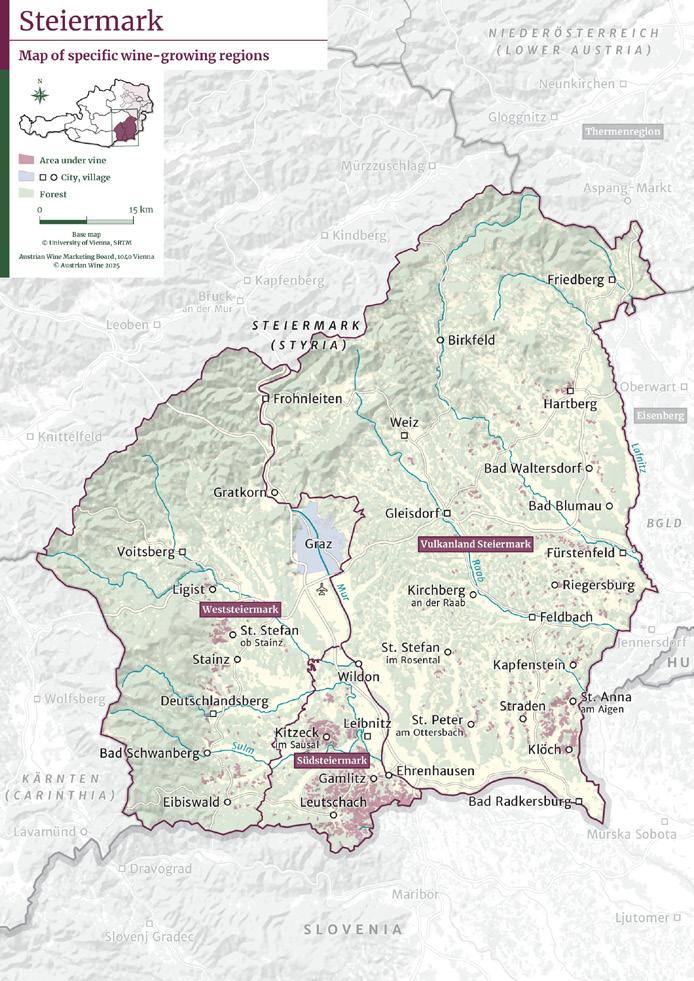
Tell us about the Weinviertel region.
“It is still something of a quiet place in the global wine world – and that’s a good thing,” says operations manager Christina Fritz. “It gives us space to think, to observe, and to work with great precision.
“The landscape is gently rolling, with loess, limestone and gravel soils that shape wines of clarity and elegance. But the true character of the Weinviertel lies in its contrasts: cool nights, warm days, dry winds – all contributing to wines with structure, finesse and natural vibrancy.
“We don’t just grow Grüner Veltliner here – Riesling is equally important to us, perhaps even more so. On loess soil, it develops tension, purity and ageing potential. It’s what gives our wines their backbone. Grüner Veltliner brings a grounded charm – spice, roundness, a sense of calm. Together, they express the place with subtlety and truth.
“What inspires us most about this region is that it allows for wines with identity. Wines that speak softly but clearly.”
And what about Liechtenstein Winery?
“It belongs to the House of Liechtenstein, one of Europe’s oldest royal families, whose viticultural roots date back to 1436. The estate is led by a young, committed team that brings international experience and a fresh curiosity to the table.
“In Wilfersdorf, Austria, we focus on origin-driven white wines from Riesling and Grüner Veltliner. In Vaduz, Liechtenstein, our 4ha of the historic Herawingert vineyard are planted with Pinot Noir and Chardonnay.”
You’re best known for Grüner/Riesling blends. Tell us more.

Its production dates back to the 15th century, but today Liechtenstein Winery is a modern business making ambitious, interesting wines. With a signature blend of Grüner Veltliner/Riesling, these are royal wines that don't cost a princely sum
The term “slow wine” has been used to describe your work. What exactly does this mean for you and your wines?
“For us, slow means thoughtful. It’s not about rustic winemaking or chasing trends. It’s about working with respect – for the grape, the place, and the process.

“We always start with Riesling – it’s the heartbeat of our blends. It brings tension, minerality, citrus brightness and incredible ageing potential. Grüner Veltliner complements it beautifully: it adds texture, depth and that unmistakable spice.
“It’s not about covering weaknesses, but about deepening expression. The Riesling keeps things lifted, precise and fresh. The Grüner grounds the wine, gives it contour and charm. Together, they open up a space in the glass that’s greater than the sum of its parts – especially when they come from the same soil.”
“We ferment partly spontaneously, use stainless steel and large oak in balance, and allow long lees contact when it serves the wine. But there’s no recipe. Every wine, every vintage, asks something different of us.
“We bring together tradition and innovation – not as opposites, but as partners. We’re not trying to make natural wine. We’re trying to make honest wine. And that often takes time.”
Are most of your wines “food wines”?
“Our focus is always on balance –freshness, structure, and a clear sense of origin. That makes the wines highly foodcompatible, especially with dishes that are nuanced, subtly spiced or texture-driven.
“But many of our wines are also beautiful on their own. They don’t demand food – they invite it. The acidity, the clarity, the gentle depth in the glass makes them enjoyable in a quiet moment, or as part of a conversation. That versatility is something we value greatly.”
Is your winemaking style constantly evolving or do you think you’ve
arrived at a successful formula that you can replicate in most vintages?
“We don’t believe in formulas. Wine doesn’t work like that – and neither do we.
“The principles are clear: origin, precision, balance. But how we express them evolves every year. The vineyards change, the climate shifts, and we grow – as people, as a team. We try things. We reflect. We refine. That process of curiosity and responsibility is ongoing. So yes, we have a clear style – but it’s not fixed. It’s alive. That’s what keeps it honest.”

How have your wines been received by consumers so far in the UK?
“It’s still early, but we’re very encouraged by the response. People are often surprised by the clarity, the freshness, and the depth of our wines – especially the blends. Sommeliers have been particularly interested in the food-pairing versatility and the sense of place.
“We’re proud to be listed at Crush Wine Bar in Durham and The Wine Library in London, and we hope to grow our UK presence in a thoughtful, personal way. We’d love for more people to discover what makes the wines from Liechtenstein Winery quietly special.”

Sponsored feature
Find out more at alpinewines.co.uk or call 020 3151 3454
Many of us are unfamiliar with Schilcher. Can you please give us a quick overview of what it is?
Schilcher is our regional specialty – a rosé wine made exclusively from the Blauer Wildbacher grape, which has been grown in Weststeiermark for centuries. The style is known for its vibrant acidity, cool freshness, and subtle spice. Since 1976, Schilcher has been a protected term in Styria, and in 2018, our region introduced a DAC classification to further emphasise origin and quality. Although it accounts for just around 1% of Austria’s vineyards, Schilcher is a powerful ambassador of our terroir – it’s no coincidence that our area is often called “Schilcherland”.
Langmann has been involved in the region for a very long time. Do you think the family has helped shape the style, and the fortunes, of Weststeiermark? We’ve been cultivating vineyards in Weststeiermark since 1746, with Blauer Wildbacher always at the core of our work. Over generations, we’ve helped shape the style of the region – experimenting, refining, and staying true to the grape. Today, we see it as our responsibility to build on this legacy while continuing to innovate. With a strong focus on sustainability, origin, and clarity in style, we want to keep evolving – both as a winery and as part of the Weststeiermark community.
How would you summarise the house style of Langmann?
Our wines are meant to express where they come from – cool, clean, and vibrant. Especially in our Schilcher, we aim for precision, juiciness, and alpine freshness with a touch of minerality. We believe in restraint rather than force –which means 100% hand harvesting, no chemical herbicides or insecticides, and a commitment to healthy, resilient vines. Our philosophy is simple: let the wine tell the story of the vineyard.
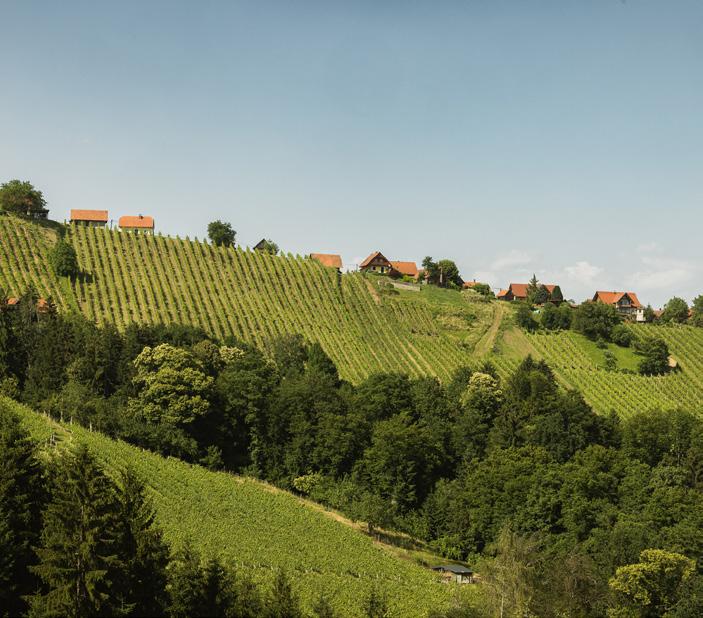

The Langmann family estate sits in the steep hills of Weststeiermark, where conditions are ideal for Blauer Wildbacher, which produces a unique style of dark, dry and crisp rosé. To find out more about this rare and interesting style that critics like Liz Gabay MW are applauding, taste it on June 18 at Drink Pink Wednesday
Independent merchants often really love deeper-hued rosés that are fullerbodied and more food-friendly than paler, less expressive styles. What’s the secret to making consumers feel the same way?
We believe it’s all about meeting people where they are. Many consumers still think of rosé as a light, easy-drinking, lifestyle wine. And that’s perfectly fine – it’s often their first point of contact. But once we take the time to explain what rosé can truly be, especially with a wine like Schilcher, the reaction is almost always the same: curiosity turns into fascination.
What we love most is that you can actually taste the origin in Schilcher – it makes the region tangible in a glass. That authenticity connects with people. In our experience, the key is to communicate honestly and respectfully, without lecturing. When we share the story behind the wine on eye level, people are usually excited to discover its depth.
What’s Blauer Wildbacher like to work with?
Blauer Wildbacher is a challenging grape – demanding in terms of site, climate, and care. But that’s exactly what fascinates us. We’ve been working for decades with small-berried, spicy clones planted by our
father in our finest parcels. Some of those vines are now over 50 years old. Climate change has made it easier to achieve the ripeness we need, but the variety still calls for patience and precision. When treated with care, it rewards us with structure, character, and unmistakable expression. For us, Blauer Wildbacher isn’t just a grape – it’s part of who we are.
You work in a spectacular landscape. Is this natural beauty one of the reasons why you try to work as naturally and sustainably as possible?
Absolutely. Our vineyards lie on steep hillsides surrounded by forests and old fruit trees – it’s a living landscape, not just rows of vines. This environment shapes us, and it deserves to be protected. We’ve been working without herbicides or insecticides for over a decade, we’re energy self-sufficient thanks to solar panels and wood chips from our own forest, and we actively promote biodiversity – with cover crops, beneficial insects, birdhouses, and even rare birds like the hoopoe. For us, sustainability isn’t an extra – it’s the foundation of everything we do

I love Mr B so much that I’ve signed us both up for the Marathon du Médoc

Like a normal marathon, but more insane
I’m back! Not that on the surface you’d know that I’d been anywhere, but it felt like I was living underwater for much of the last year. I didn’t recognise this happening, of course. It’s not like watching a bath running over – instead, a dripping tap that gradually fills the sink.
But here I am. After an enforced break from my favourite hobby (if you’re wondering, I do also question how this became so important to me) I am back running. I’m not fixed (and let’s not get into that debacle – it has a tendency to drag the tide back in) but I can once again enjoy pounding those pavements.
I am extremely grateful to be able to do this again. It isn’t to be taken for granted; I know that now. Even that day I ran with a self-induced whisky hangover, I really appreciated being outdoors, running up a
hill and (naturally) whinging about it with my similarly-afflicted running buddies.
I’ve got it so bad that (aforementioned whisky sesh aside) my weekly alcohol consumption has dropped below the government recommended allowance. This is so that I can get up early in the mornings and get some fresh air in before a day in the shop. I don’t want to say that I find this troubling, but it is a monumental change. I was teenager of the 90s and this is the first time that I have achieved a “healthy” state
of drinking since my shameful Lambrinion-the-field days.
For years I’ve been telling my customers that drinking less but drinking better is the way to go, and finally I’m following my own advice. I should have done this years ago. So what am I drinking instead? Well, like the bougie bitch that I am, I’ve taken to drinking my way up the wine price brackets when I am drinking, and plenty of water when I’m not.
Idon’t want to get into the nonalcoholic/dealcoholised wine debate because I don’t (yet) like them. It’s not that I am an alcohol purist; I don’t really enjoy anything after the first glass of wine. Booze “permits” me to be more opinionated, more of a knob and definitely more sweary, if you can imagine those things. I’d therefore happily never drink alcohol again if wine without it tasted good. Let’s face it, we already know I am perfectly capable of being offensive while sober.
Only last week Mr B told me that he would never divorce me because “there is no hill too small for me to pettily die on”. If that isn’t love, I don’t know what is (at the time I was arguing with the alarm company about the legality of changing contract prices with no notice to me. I was, as it happens, right).
In a similar show of devotion (some might call it retaliation), I have signed both of us up to run the Marathon du Médoc in September in Bordeaux. He’s never run a marathon, and doesn’t really have the desire to do so, but made the mistake of saying that this is the one he’d consider. Well, thinking about it is out of the window – and training is in! For anyone that hasn’t heard about this insanity, this is a 42km race in compulsory fancy dress, with 21 wine stops followed by breaks for oysters, steak, cheese and then ice cream.
This is a 42km race in compulsory fancy dress with 21 wine stops and more for oysters, cheese, steak and ice cream
Clearly I’m going to have to work on my drinking again over the next few months so that I don’t embarrass myself. Are we mad? Undeniably. Will we still be married at the end of this? Only time will tell.
Cat Brandwood is the owner of Toscanaccio in Winchester


How does crémant feature in your range? Is it a category that still needs a bit of explanation to consumers?
Jez Greenspan: Crémant works really well for me. I’m based in Balham and my customers drink tons of Champagne, but they want a grand marque, so they’ll go to Waitrose, Majestic or whoever has the cheapest deal. Instead I stock two small grower Champagnes and I sell a lot of crémant because my customers have the idea that they’re not missing out if they drink that during the week and have Champagne at the weekend. I have Crémant de Limoux and Crémant de Bourgogne but I’m looking to bring in more regions because they work really well.
Jérôme Poussin: It’s the same with us. I’d say if 20% of our sales are fizz, then it


We invited five independent merchants to London Cru to discuss a range of topics, including the crémant category, sales of French wine generally, low and no-alcohol wines and retaining customer loyalty.
Our session included Duncan Gammie, The Wee Vinoteca, Hitchen; Hal Wilson, Cambridge Wine Merchants, Cambridge; Robin Eadon, Dulwich Vintners, south London; Jez Greenspan, The Wine Twit, south London; Jérôme Poussin, Askew Wines, west London; and Chris Davies, channel controller for on-trade, cash and carry and independent merchants at Les Grands Chais de France, our partner for this round table.
would be 5% Champagne, 5% Prosecco and 10% crémant. There’s some good stuff, particularly from Limoux and the Loire.
Hal Wilson: I haven’t seen a lot of marketing for crémant but people have just hooked onto it and you hear them say “I like crémant” in the same way they’d say “I like Prosecco”. I can understand that Champagne looks quite expensive and Prosecco loses its appeal, English sparkling is too expensive to fill that gap, so crémant slots in. You could say it’s slightly irrational or herd behaviour, but I’m very happy about it.
Jérôme Poussin: It helps the liqueur department because crémant is an obvious choice for a Kir Royale and you can upsell with a cassis or a framboise.
Duncan Gammie: We’d been hunting for a good crémant that we could get excited about, and we found one about six months ago. It sells quite well, but not anywhere near as well as I expected. Like Hal was saying, if you imagine you’ve got Prosecco at the very entry level, and you’ve got Champagne, maybe English fizz at the top end, we found that actually in the middle there may be more options and more adventurous customers as a result. While we’ve got a crémant at £22 a bottle, I also have a méthode cap classique at the same
price that probably sells better. We’ve had Portuguese espumante at 17 quid, which also sold really well, so I agree that Prosecco allowed people to start drinking fizz midweek and I think now that has created a market for more adventurous sparkling wine options.
Robin Eadon: For me, is it is the exact opposite to that. We’ve been bringing in a Crémant de Limoux for over a decade, and that is the best-selling product in the shop of any bottle.
I think people had a binary view of sparkling wine, so they’d think “do we want Prosecco, or do we want Champagne?” And in their heads that translates to: “do we want cheap, or do we want expensive?”
That’s forgetting Cava, which just disappeared into the abyss. We do well with the Jansz from Tasmania and there’s some other traditional method stuff coming from Italy, which is interesting, not necessarily just Franciacorta.
I don’t think consumers quite know what the word crémant means, but I think in their head it represents cheap Champagne. There are a couple of people

who fixate on Bourgogne as a region, but generally as long as it has crémant on the label, they are happy. Ours is on the shelf for £18 and probably getting to that £20 mark.
Hal Wilson: It’s interesting that it’s just become a brand which is non-specific to people. They have no idea about the regions, it’s just crémant.
Robin Eadon: If you’re talking to a customer with slightly more wine knowledge then it does matter to them where it’s from, but I think there are a lot of people that just genuinely enjoy it. And I think that’s a question that doesn’t get asked enough: do you enjoy it? It doesn’t have to be the thing that you’ve read somewhere that you’re supposed to like. There are some decent crémants in the supermarkets now as well, so when people shop there, they can find the word crémant, and they feel safe.
Duncan Gammie: Is it us, the merchants, creating that soft brand? If a customer asks me “what’s crémant?” I’m not going to go into the complexities of the different regions but I would say, it’s made like Champagne but outside of Champagne. I’d explain how Champagne is protected in the same way that Stilton and Melton Mowbray pork pies are, and I think from a customer perspective, that’s enough for them.
Robin Eadon: I think that’s the maximum before they just switch off.
Jez Greenspan: We do have to be careful that we don’t dumb it down and it doesn’t go the same route as Prosecco and Cava. It is about educating our customers. There are some who don’t want the intricacies, but there are a lot of customers who want to know more about it. You don’t have to go into great technical details about dosages and blends, we just need to give them a little bit of an understanding of what the differences are and the different flavours.
Hal Wilson: And vintage! It’s probably
a small part of the market, but our Crémant de Loire is nine years old and has had extended bottle age, so it has some autolytic character. It’s useful to have something that’s more like a vintage Champagne in that category.
When people ask me what more they should know about crémant, I would say that it’s easy to cross-sell and to retain customers and offer them a bit more regional identity.
It’s really important to us to keep up the knowledge base for our team as well as the quality and the value. I have tasted a lot of crémants and they’re not all uniformly good. The point being, we have to do our job still.
Duncan Gammie: I think we have that classic wine merchant dilemma: as wine enthusiasts we want something to get really excited about and sell to our customers. The good version of me wants to tell as many people as possible about this new thing and share it, but the bad version wants to keep all the good stuff for myself, because if we tell too many people, it’ll mess it up.
You want a certain number of people to enjoy crémant, because they’ll really enjoy it, and it’s a great thing to offer and talk about and get customers excited about, but the second that it becomes that kind of supermarket thing, there’s a race to the bottom.
Chris Davies of Les Grands Chais de France says: “Crémant is certainly a focus for us and we have wineries in all the eight crémant-producing regions, soon to be nine, as Provence is making a play.”
Salasar Carte Azur, Crémant de Limoux NV
“This Limoux is probably our least expensive and is just a snapshot of the Salasar range. It has 12 months bottle ageing. It’s very refreshing and light, with aromas of lemon and sweet almond.”
Moillard Grivot Prestige, Crémant de Bourgogne 2020 “100% Chardonnay with fine and delicate bubbles. This has had 15 months on lees, so there’s a little more bottle ageing here. Notes of white flowers, hazelnut and peach.”
Arthur Metz Grand Terroir Schiste Schieferberg, Crémant d’Alsace NV
“A blend of Pinot Gris, Pinot Noir and Riesling. The blue schist gives this crémant a strong minerality and a saline edge. There is a perfect balance of the acidity and creaminess with the apricot and plum flavours.”



Les Grands Chais de France owns vineyards in some of the greatest winegrowing regions of France, Chile, South Africa, Spain and Hungary. Despite its size, LGCF is still a family company, with Joseph Helfrich at the helm since 1977. All of its properties are engaged in environmentallyfriendly practices. Contact chris.davies@lgcf.fr for pricing details. Duty paid deliveries can be arranged for as little as 20 cases.
In The Wine Merchant survey of independents, France was once again named the most commercially important country. Where are you finding interest and value in France generally?
Duncan Gammie: It’s impossible for someone on their wine journey not to look to France in some major way. What we’re finding is that it’s not the starting point for lots of people. There are so many things we can say are brilliant about France, but clear understandable labels to entry-level customers is not necessarily one of them. If someone comes in and says, “turns out I really like Chardonnay, have you got any from France, because I can’t find any?” you have to explain, but once you break that down, then you get people in.
A lot of us have customers who had to learn that Chablis meant Chardonnay, but I think when the younger customers are asking, “turns out I drink Shiraz and I know that because I buy Aussie Shiraz, what else will I like?” you have to give people a certain level of knowledge and confidence before you can take them to France if they’re not already there.
Robin Eadon: France is our largest section and we import a lot from France as well. Bordeaux and Burgundy are still solid. Our shops are in Dulwich and Blackheath so we have customers of an age where they will buy quite traditionally.
We’ve always had fun in the Languedoc, and in those regional areas of France. I had a big focus in Cahors when I started and we’ve always picked up fun little bits down there. You can get great wines there if you look hard enough.
Jérôme Poussin: The Languedoc is
running well and I think it’s because people have such fond memories of it. Brexit has meant people haven’t been spending so much time in France visiting or travelling, but they know they can come into the shop and buy wine from their favourite regions.
Robin Eadon: Our range of stuff that isn’t French and Italian has doubled, probably in the last decade. Bulgaria, Armenia, Georgia, Uruguay … people are a bit more aware of those wines. I’m awful with social media, so I have no idea if this is down to social media or not. But while France seems absolutely solid, there will be a point where people will not buy Burgundy because it is insultingly expensive, and Champagne as well.
There are reports that they can’t sell all the wine and the wine lakes are back, but they also say they haven’t got any fruit, so the price is going up.
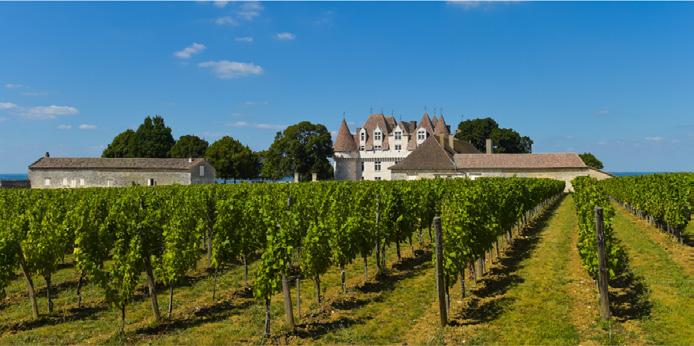
Hal Wilson: Weirdly, if you want to buy something young, it’s going to cost you more, but you might be able to get something that’s mature and lovely from Bordeaux for half the price it was released at, because that’s where the stress point is.
What was a fairly rational system has just become completely irrational and won’t be helped with tariffs from the US.
There is still something in the mind that reminds us why the prices are higher because there’s a real emphasis on quality and the wines age well. We do well with these parcels of wines coming out of
Bordeaux at a fraction of the price that they originally wanted to sell them. If they can’t sell them at price X, they have to sell them at something or throw them away. Both are unpalatable options, but they want to get something back, and that’s very available at the moment.
Duncan Gammie: If their concern is price then people will come to us to find the next best thing. If the Burgundy they used to buy has got super expensive, they’re not going to go to Tesco and take no advice and just pick according to a deal or label. They’re less likely to go online and take a punt on a 30-50 quid bottle, they want to go and have a conversation with someone. Then if you can sincerely say, “this wine is from the next-door village, or the winemaker used to make wine there” etc, they’ll say, “cool, thank you very much”.
Hal Wilson: Some classic red appellations do make great white wines. There are some really good and lesser-known white wines coming out of Lirac and Côtes du Rhône AOC. So we’ve promoted white wines from classically red regions, but those regions are familiar to people and there’s a good quality ladder there and cross-promoting the red brand with the white wine just seems to be working.
Robin Eadon: France has the ability to essentially do everything but there are some issues. Gaillac and Bergerac have a massive image problem. We’ve had wines from really good producers but for example if they put Bergerac on the label, all of a sudden it knocks it down.


“It feels like every single time there's any type of budget or statement, it’s always attacking the alcohol industry. It's quite difficult to find anything they’ve done that we could put a positive slant on.”
Robin Eadon, Dulwich Vintners
“There’s definitely a group of people who are brand led. Especially when it comes to buying Champagne: ‘It must be these brands, because that does something for me, or the people I drink around'. Luckily there are also people who are like, 'screw that nonsense. I don’t care. I want good wine and as long as I don’t have to pay silly money for it, I’ll be really happy’.”
Duncan Gammie, The Wee Vinoteca
“We are businesses selling wine to people because we love wine. We’re not doing it to poison people. If you’ve got people who won’t have that experience because they’re not interested in drinking wine, maybe we have to understand the role that nonalcoholic beer and wine play.”
Hal Wilson, Cambridge Wine Merchants
“We've got lots of things with natural skin contact and our pét nats have gone from zero sales to quite a lot, but I'm unwilling to accept that somebody can exclusively drink pét net and skin contact, and that's it. They’re not necessarily youngsters – I have 45 and 50-year-olds coming in saying, ‘have you got wine that doesn't give me a hangover?’"
Robin Eadon, Dulwich Vintners
Do any of you run loyalty schemes or wine clubs?
Robin Eadon: Rewarding your customers for coming in and buying repeatedly is an interesting one. Margin expectation on spirits is different to the one on Champagne, which is different to the one on still wines and so on, so we can’t work out a way of doing it across so many different products. The majority of loyalty schemes, are about controlling data and I’m not sure I can do anything with my data. I know what my customers are buying because I sold it to them.
Duncan Gammie: I have a very different point of view on this one. Our most basic form of it is based on random acts of kindness. We have a system where any member of staff can give one thing away a month to a customer. It could be that they found out someone has just moved house and we went and dropped off a bottle of fizz, or it could be a birthday. It’s just ways of recognising the loyalty of regular customers.

Could it be this man's birthday?
which is built into my prices to start with. I have thought about doing something similar to Duncan with the subscription but it will be a big investment in terms of time.


We do also have a wine subscription, which is a massive part of our business. We have 171 subscribers. They buy a case of wine every two months spending from £85 per case to £300, so from a business perspective it’s really good consistent revenue. The only discount I offer is to those people. They get a flat 10% discount on anything they buy, from drinks at the bar to a ticket for an event.
We have a part-time member of staff who drives around for a day dropping off the cases to customers’ houses. It builds a level of loyalty from that customer that’s really hard to beat.
Jez Greenspan: I do a standard 10% off when you buy six bottles, excluding spirits,
Jérôme Poussin: We do promotions on some of our entry-level wines. So for a time we’ll put a £12.99 bottle on at £10.90. We put that at the front of the shop and it works – it gets people through the door.
Hal Wilson: I think Duncan’s idea of only giving special pricing to people who subscribe is a really good one. I think we’d have difficulty with that, because there are lots of people who I would guess are subscription-reticent. Discounts on their own are not going to create loyalty, because if everybody else is offering discounts you just shop around for the best one. I think other brand values, such as our level of service and our knowledge that we all offer, bring loyalty to our businesses. We haven’t reinvented the wheel here, but if you do all of them pretty well, then people trust you for their next purchase.

"CONSUMERS IN THE UK ARE KNOWLEDGEABLE AND CURIOUS ... THAT SUITS OUR PROFILE AS A PRODUCER"
George Sara, co-owner and general manager of Chateau Ksara in Lebanon's Bekaa Valley, is feeling positive despite recent turmoil in his home country – and has a special affinity with the UK market, where Ksara's wines have a long-standing relationship with Berkmann Wine Cellars.
Sponsored feature
Find out more at chateauksara.com and berkmann.co.uk

How’s life at Chateau Ksara? Less stressful than it was during harvest? For the last 170 years we have lived with ups and downs. We are in a turbulent part of the world and crisis management is built into our DNA. At the moment the situation is quite optimistic and we are looking forward to summer.

You’ve said before that you want the world to see a more positive image of Lebanon. Wine sends a message of tradition, hospitality and civilisation. When you come from a part of the world that generally sends out negative images then wine, and of course food, can help reverse that trend by promoting our family and human values.
Is Lebanese wine culture less linked to France these days?
We are very proud of our French heritage. France played a major role in shaping the modern wine industry and Ksara has enjoyed a very close relationship with the Jesuits, many of whom were French, so the whole francophone winemaking culture sits very comfortably with us. In terms of Lebanese identity, we use white indigenous grapes, while the southern Rhône reds that have been the backbone of the industry for nearly 170 years and which performed so well in the Bekaa are practically considered indigenous.
Tell us a bit about the terroir you work with.

The Bekaa’s selling point is altitude. Our vines start at 1,000 metres and go up to 1,600 metres. This gives us valuable freshness and lower abv, and the cooler nights allow longer ripening. The vines are planted on the slopes of both the Lebanon and Anti-Lebanon mountains as well as the plateau between them. All these aspects give different expressions.
How do you think your winemaking style has evolved over the years?
We have 17 wines ranging from easy-drinking, limited-intervention, fruitforward blends with this distinctive sense of place to more international-style blends that see wood and are meant to age. I would say our portfolio offers a complete snapshot of what the Bekaa terroir can express. That is not to say that we do not keep one eye on what global consumers demand and we are agile enough to respond to those demands whenever we feel we should. The Merwah variety, which we launched in 2017, is a good example. We never really considered it for wine but we realised that consumers wanted something that they considered authentic and we were in the position to deliver. It’s now one of our bestsellers.
How would you summarise Chateau Ksara’s relationship with the UK?

UK consumers are knowledgeable and curious and so they represent a market that suits our profile as a producer from one of the more esoteric winemaking regions. The market is also important on a personal level as my late mother was British and she was very proud of the wine as an ambassador for Lebanese values and culture. Finally, our relationship with Berkmann Wine Cellars is very strong on every level, from my relationship with the owner Rupert Berkmann through to the sales team, all of whom appreciate our wines, and that is another reason that makes operating in this market so enjoyable, even if it’s challenging.
What would you like to achieve next at Chateau Ksara?
We want to reinforce the message that we are the oldest modern producer with a range of wines that is a reflection of everything good coming out of Lebanon today. The establishment of Chateau Ksara in 1857 was arguably the beginning of the modern Lebanese wine industry. We have heritage and we have a back catalogues of wines to rival most wineries in the world. At a broader level we also want to reinforce the message of Lebanon as a serious and incredible wine producing country. Wines cannot be sold in isolation. If you sell the country, then your job suddenly becomes a whole lot easier.

Ray O'Connor MW leads a masterclass for independent merchants to help them find extra dimensions to Provence rosé. By Jacob
Stokes
It’s impossible to think of another region that has been more influential on an entire category of wine than Provence: it has redrawn the rosé world in its image. Provence rosé has emerged as one of the wine industry’s most powerful brands. But what’s behind this success? And, digging a little deeper, what regional variance can be found?
Ray O’Connor MW is tasked with answering these questions, and many more, in a lunch attended by a group of UK independent merchants.
Birds, bees and balance
Ray starts with the biodiversity of the
Provence landscape. “The whole place just feels alive,” he says. “Unlike some wine regions where large-scale viticulture of rows and rows of vines are the norm, here it’s winding patchworks of vines surrounded by forestry, buzzing with thriving populations of birds and bees.
“The woodlands that surround the vineyards host the bats which control insect populations and reduce the need for synthetic pesticides. It’s perfection in the balance of nature.”
Rosé’s a relative newcomer
It’s worth noting that, despite its sleek modern image, vine cultivation in
Provence dates to 600BC. But it wasn’t until the 1970s that a group of visionary winemakers took a huge risk and decided to focus on premium rosé. Fast forward 50 years and today, 89% (133 million bottles) of the region’s output is dedicated to the style. And unlike other regions, most of Provence’s best vineyard sites express themselves through world-class rosé.
Three AOPs, thousands of possibilities “Provence stretches across three AOPs,” says Ray. “They are Côtes de Provence, Coteaux d’Aix-en-Provence and Coteaux Varois en Provence. They each have subtle differences and qualities.
“Côtes de Provence is the largest area, with the greatest number of growers and co-operatives. There are many serious operators down there and many wine merchants too. It is an all-rounder for classic fruit-forward rosé.
“Coteaux d’Aix-en-Provence has a more moderated climate due to its exposure to the tempering effects of the Mediterranean and its higher altitude. The wines here can be characterised by their freshness and lightness in comparison.
“And finally, you have Coteaux Varois en Provence, which is known as the greenest for two reasons. It has the highest proportion of rainfall and the largest amount of organic viticulture. The wines here seem to display more energy, vibrancy and minerality.
“So, summarising that to the customer, which is what matters most, I would say Côtes de Provence offers lots of fruit depth, Coteaux d’Aix-en-Provence is fresher and lighter and Coteaux Varois en Provence is energetic and mineral.”
Ray adds: “On top of all of this, Côtes de Provence is home to five terroir designations – Sainte-Victoire, Fréjus, La Londe, Pierrefeu and Notre-Dame des Anges – which you might think of as ‘crus’ or which have more specific subtleties and nuances in style.”
Grapes to get to grips with “Primarily, the grapes in the region are Grenache, which lends structure; Cinsault,
which gives vitality and vibrancy; Syrah adds colour and fruit intensity. Then less commonly you have grapes like Cabernet Sauvignon and Mourvèdre that add acidity.
“Tibouren is a local variety that is used in small amounts due to its scarcity, but when it is included, it lends breadth, even at percentages as small as 3%-4%,” says Ray. “In addition, you have white varieties such as Clairette and Bourboulenc. Vermentino, also known as Rolle, adds a citrussy freshness, aromatic floral notes and a touch of minerality, contributing to a balanced and complex profile.”
Big names but small indies too “Provence is home to some great brands, but for every big brand there are a host of small independent growers. The understanding that the 479 independent wineries have for their land is astonishing.

Jaqueline Adams
Fine Wines of Mayfield, East Sussex
“We stock around 30 rosés in the summer and 20 in the winter and our customers are very keen on exploring the different levels of quality in Provence. The brands rely on a solid entry-level wine for customers to work up the price ladder. It’s also becoming less seasonal; people are choosing to
They’re typical rural farmers who know the place inside out. There are 32 names for different winds in Provence and they know exactly which wind is coming in which direction, when it will come and what the effect will be on viticulture.
“They also understand the extremities of the environment. It’s extremely sunny, they get 250 days of sunlight per year and water scarcity is an issue. Over centuries, unique terraces called restanques have been built, not only to store the vital water when it does fall, but also to create communities of biodiversity within the walls themselves.
“This hasn’t been engineered in a lab. This is the depth of generational knowledge on display. The region offers a wide range of styles through grape varieties, origin and winemaking techniques.
“The terroir of Saint-Victoire can bring a positive tension and vibrancy to a wine, while the wines closer to the coast, such as La Londe, have a natural, marble-like roundness to their texture.”
Food friendly
The two main sharing platter courses are each paired with three wines. The first course includes both vegetarian dishes including sheep’s ricotta, pink fir potatoes and radicchio as well as cured beef carpaccio dish. The second course includes wood-roasted sweet potato, fiolaro broccoli and sage ravioli, roasted sea bream and braised pork meatballs.
And despite such a wide range of
drink Provence as a quality option all year round.”
Koletka Pukacz
Vinotopia, Nailsworth
“Provence has established such a trendy brand image. Many of our customers buy large-format bottles for weddings, gifts and other events because it’s a statement.”
dishes, the wines hold up well to each course. The precise acidity and mineral edge of Provence rosé famously makes it gastronomically versatile. Ray says: “When it comes to making quality rosé, it would be fair to say that nowhere else offers the breadth of quality, style and consistency throughout a single region or appellation as Provence”.
The wines we tried at Gold, Notting Hill
• Bastide de Fave, Bastide de Fave, Coteaux Varois en Provence, 2024
• Maison Mirabeau, Etoile, Côtes de Provence, 2024
• Les Quatre Tours, Vilandria, Coteaux d’Aixen-Provence, 2024
• Château d’Astros, Amour, Côtes de Provence, 2024
• Domaine Le Loup Bleu Croix du Sud, Côtes de Provence Sainte-Victoire, 2024
• Château Angueiroun, Prestige, Côtes de Provence La Londe, 2024
• Château des Annibals, Suivez-moi-jeunehomme, Coteaux Varois en Provence, 2024
• MIP Diffusion, MIP Classic rosé, Côtes de Provence, 2024
• Domaine Des Oullières, Harmonie, Coteaux d’Aix-en-Provence, 2024
• Domaine La Navicelle, La Navicelle, Côtes de Provence, 2024
• Maison Fabre, Château de l’Aumérade, Cuvée Marie Christine, Côtes de Provence 2024
• MDCV Sarl, Ultimate Provence, Côtes de Provence, 2024
Charlotte Dean
Wined Up Here, west London
“Sales of Provence and rosé are almost entirely dictated by presentation. A pale colour, clear glass and eyecatching bottle designs have become essential.”
Feature published in association with Vins de Provence vinsdeprovence.com/en
Calera was born from a great wine story. The estate’s founder, Josh Jensen, was inspired by the great wines of Burgundy and understood that if he was to emulate them at home in California, he would have to find limestone soils. No mean feat: it took him nearly three years before he landed at the limestone hilltop called Mt Harlan. He spent every last penny he had on the site, planting Pinot Noir vines with his own hands, all the while living in a campervan.
Obsessive? Perhaps even a little crackers … but Jensen created an estate that has become synonymous with exceptional Pinot Noir and Chardonnay wines, revered the world over. Robert Parker once described Jensen as “one of the most compelling Pinot Noir specialists of not only the new world but of planet earth”.
Jensen sold Calera to The Duckhorn Portfolio in 2017, but not before he had rigorously trained his protégé Mike Waller. “I started as the assistant winemaker in 2007, and Josh was the front and centre guy,” Waller recalls. “When I became head winemaker three years later, Josh would say, if anyone asks, you tell them that I am the executive head winemaker!”
Jensen it seems, didn’t loosen much grip on the reins, but the two clearly worked well together. “We agreed on ripeness and when to pick,” says Waller. “I am more technical than Josh was, but we were aligned on taste, and had similar palates.”
Jensen died in 2022, but his heritage is in secure and respectful hands. Waller lives and breathes Calera. When he talks about the vineyards, it is with an intimacy and depth of understanding that comes from love. He continues to work the vineyards with the commitment to stewardship that steered Jensen, and is proud of the estate’s organic certification.
Calera has six Pinot Noir vineyards, all on Mt Harlan: Jensen, Selleck, Reed, Mills, Ryan and De Villiers. The single-vineyard wines are released on allocation each year.
Jensen, the flagship vineyard, was planted in 1975. It occupies four hillside
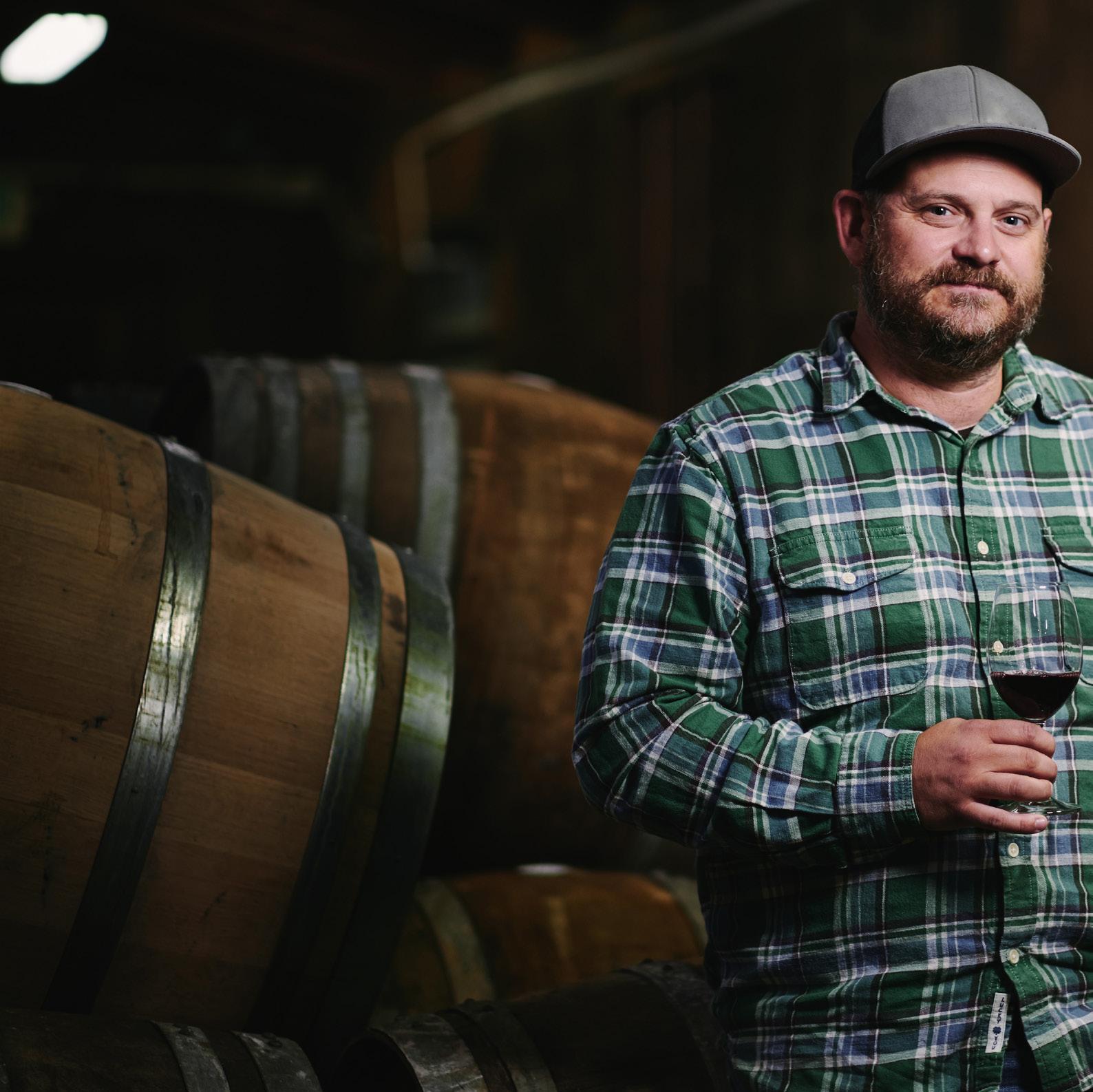
In his quest to make California wines that could give Burgundy a run for its money, Calera founder Josh Jensen was obsessive in his choice of terroir. Today, his protégé Mike Waller is making wines that justify Jensen's groundbreaking work.
Calera wines are imported in the UK by Top Selection. Find out more about the range at topselection.co.uk
Sponsored feature



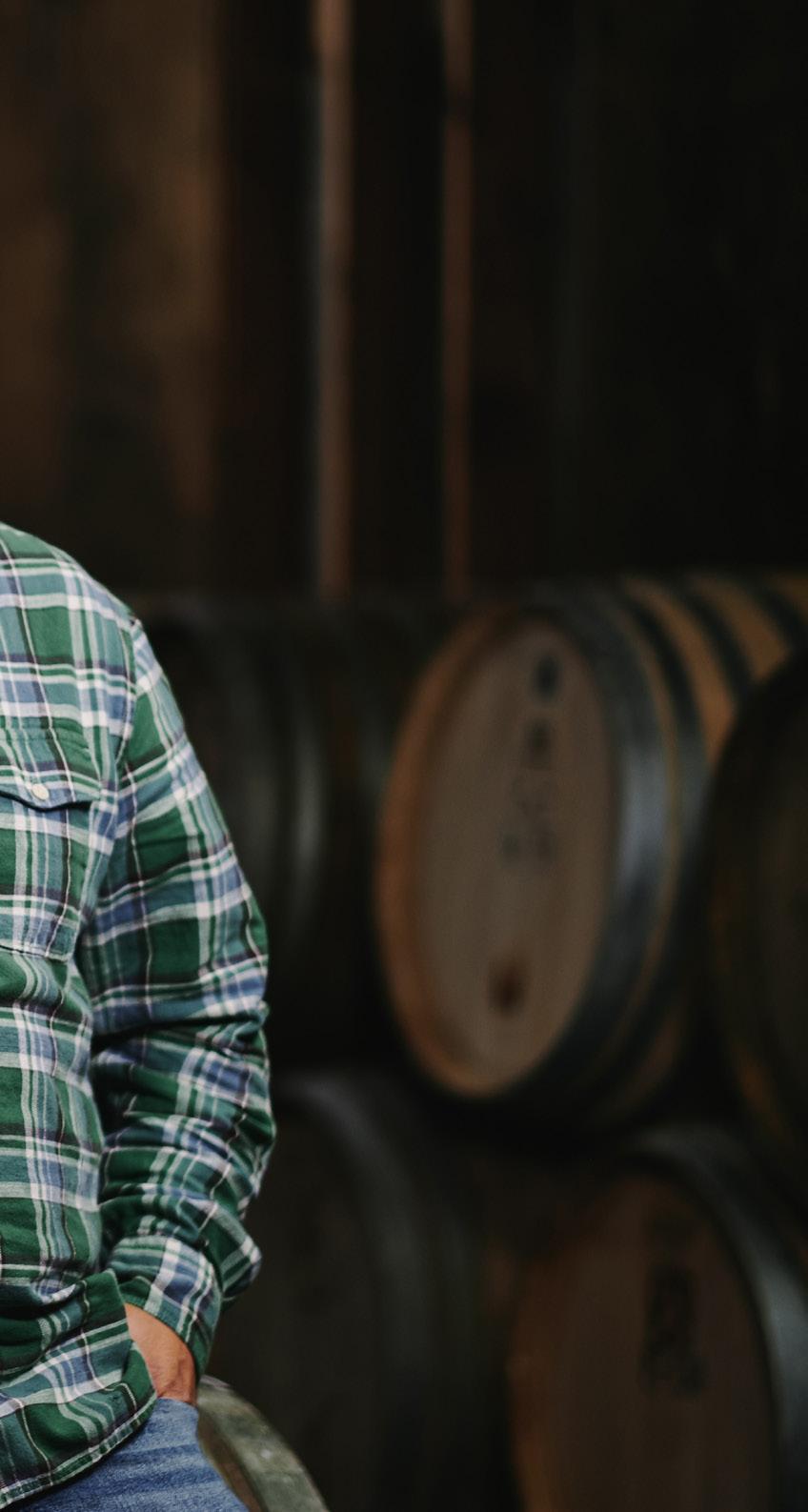
blocks, each with a different exposure.
Mills vineyard has recently been ripped out and is being replanted. Vines in this south east-facing plot, which has yielded fragrant, spicy Pinot Noir, were first planted in 1984 on their own roots, “which is partly the reason we have ripped it up: the vines can’t thrive in the dry calcareous soils, so they’re not productive,” Waller explains. “Also, the site is late to ripen.” The vineyard is being replanted on grafted rootstock, using cuttings from Calera’s original vineyards.
De Villiers is Calera’s second youngest vineyard and, even when Jensen was alive, it was a source of frustration for the team.
The wines could be bitter and phenolic, driving Jensen to his wits’ end, and almost to a decision to rip the vineyard out. Waller stepped in and suggested that a solution might be to try destemming. With wines typically being 100% whole-cluster fermented, it was a significant step. This was in 2007 and tasting from barrel, the Jensen-Waller duo was delighted with how good the wines were.
“Over time, as the vines have aged and the roots have gone deeper into the limestone, the fruit has changed and by the time 2022 came, we were back to full cluster,” Waller says. He believes that it is at de Villiers that he has had the biggest impact, picking smaller and smaller selections over time. The wines from here are typically precocious, fruit-forward and with a rich mouth feel.
Ryan vineyard, planted in 1998, it is the youngest and also the highest, reaching 762 metres above sea level. For Waller these vines have “more layers, more complexity … the wines resemble bright red fruits, have a more grippy edge with a long finish and great complexity”.
It says much of the respect that Jensen had for the people around him that the vineyards are all named after someone. Bookworms might recognise Marq de Villiers, author of The Heartbreak Grape, which tells the Calera story. Jim Ryan was the estate vineyard manager until 2017, and had no idea the site would take his name until he saw the first vintage in bottle in 2002. Everett Mills was a friendly neighbour who lent a hand in the early days.
Waller anthropomorphises the wines.
“Mt Harlan Ryan Vineyard Pinot Noir is the child that’s heading to Harvard, is following in his big brother’s footsteps and is looking to become a doctor or something similar. The Mills Vineyard Pinot Noir smoked a lot of pot back in the day but has grown up now and is running a social service programme. De Villiers Pinot Noir is that kid who just doesn’t want to go to school and is still out there trying to find himself, spending his time going to Grateful Dead shows.”
Pinot Noir reigns supreme at Calera, but equal attention should be paid to the stellar Chardonnay and Viognier wines. Jensen fell for Viognier’s charms on a trip to the Rhône and was one of the pioneers of the grape in California, planting in 1983. The vineyard gives
low yields, but grapes with impressive minerality. Mt Harlan Viognier is driven by fruit complexity and acidity. Waller says: “It’s not overly alcoholic or soapy. It has never seen new oak and is fermented in concrete.”
Mt Harlan Chardonnay is a leaner wine than many of its Californian contemporaries, thanks to limestone soils. “I think it was a wine that was maybe a little overlooked in the past, and it’s potential not fully understood, but today it has more lees and barrel ageing, which has made it more robust, with greater tension and a longer finish.”
Fruit for the Central Coast wines comes from growers that Calera has worked with for many years. “I think there’s actually more winemaking in these wines because we’re piecing vineyards together and blending to make approachable wines that work well with food,” says Waller.
What wine would Waller open if he could share a glass with Jensen today? “The 2021 Ryan, because Josh would taste it all grown up, softened up and with more complexity. Also, the 2022 Mills which was the last vintage, which never made it to market: to show what Mills was at the end of an era.” 2025 is Calera’s 50th year, which Waller acknowledges might not mean much to some old world properties. “In California we have made it and now we have to hold on to it for dear life, to pass on to the next generation,” he says. “I want people to be talking about Calera in a hundred years, and how great it is. It is important we find the next generation who understand the culture, the standpoint, the wines and the vineyards.”

Josh Jensen
Waller has been with Calera for 18 years, and you sense he is just getting comfortable. Whatever they’re saying in 2125, it’s a racing certainty that Jensen’s vision and Waller’s devoted attention will be at the heart of the story.

Accounting for 33.6% of Portugal’s total production, vinho branco represents a significant element of the country’s exciting wine landscape.
Vinho Verde is a commercial powerhouse that spearheads the reputation of Portuguese white wines in the mass market. And yet it has faced the same challenge that keeps many Portuguese white wines in the shadows: how to successfully market indigenous blends in an effective, digestible way.
When consumers buy a Vinho Verde, they don’t give much thought to Azal, Arinto, Alvarinho, Avesso, Loureiro, Trajadura or any of the 45 permitted varieties. It’s just Vinho Verde, directly translated as “green wine”, suggesting a wine to be enjoyed in its youth. For the most part it’s known as light, zesty and fresh with a slight spritz – a line that many a merchant will have repeated.
Despite its complicated varietal origins, Vinho Verde is primarily a recognised, reputable brand, reliant on a certain level of homogeneity. So how do other regions in Portugal become more recognisable
Jacob Stokes examines how Portugal's attitude to field blends is changing – and what this means for two of its greatest white wine regions
without having to be stylistically uniform?
Well, trendy branding can be helpful. But, as we hear time and time again, it must be about focusing on what makes each region unique, and running with it without hesitation, because the wines will ultimately speak for themselves in the glass.
But first, consumers need to hear a story. And there is a distinguishing element between Portugal’s two highest quality white wine regions that creates an
interesting talking point.
The Douro and the Dão share a catalyst that sends them in opposite directions in terms of viticultural philosophy: field blending. Ths time-honoured method, enthusiastically adopted in the Douro, is being increasingly shunned in the Dão in favour of a more precise varietal approach.
But despite their differing visions, both regions share a trajectory of making incredible wines that are worthy of our attention.
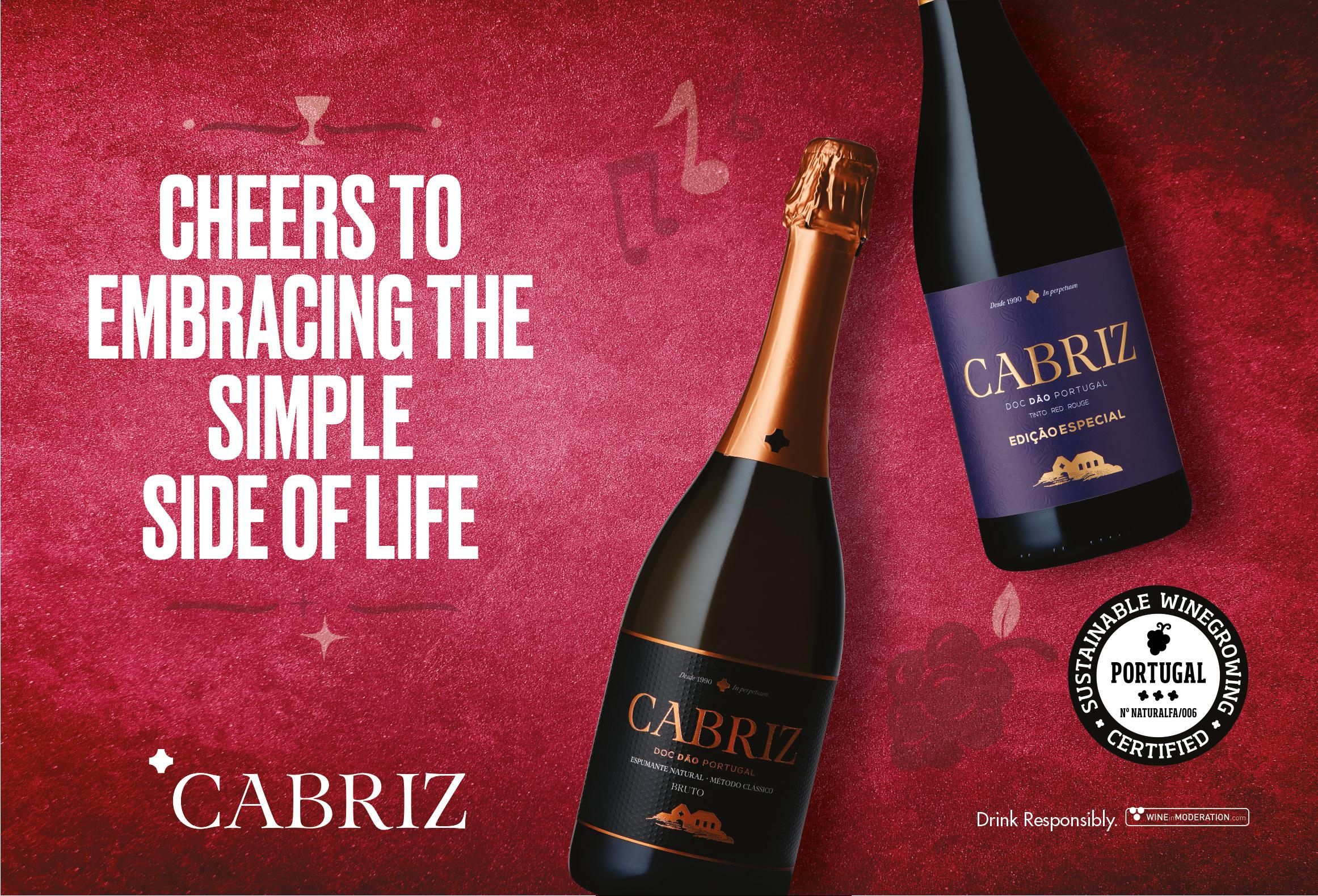

With the weight of what seems like a dying art carried on its terraced shoulders, the Douro takes field blends to heights unseen anywhere else in the world of wine. And the tradition is deeply ingrained in the winemaking culture.
I recall speaking to Daniel Niepoort about his benchmark Tiara white before I knew it was a field blend, and I routinely asked him for the percentages of the blend by variety, a reasonable question in most cases. He simply replied: “I have no idea.” Initially I was taken aback but, as he explained, to him it’s irrelevant what the exact formulation is – as perhaps it should be to us.
And that’s because the wine captures
the essence of the Douro regardless. It is terroir winemaking, which doesn’t necessarily have to be constructed through precise percentages and in-depth soil maps. The terroir is encapsulated through the concentration of old vines, the freshness of altitude and the unique harmony of historically mixed varietal vineyards.
The magic of the field blend proves that marketability doesn’t necessarily depend on a calling-card variety or a widely recognisable style. It can be driven, too, by the individuality of winemaking traditions and philosophies.
The Douro is a world heritage site that tells its climatic story through three distinct subregions. To the west, and closest to Atlantic influence, is the Baixo Corgo – the coolest, wettest and most fertile region with the highest density of vines. Next is the Cima Corgo, located centrally and known as the heart of the Douro. Finally, furthest east, is Douro Superior, the largest, hottest and driest subregion. This is also the most continental with the highest variation in temperature between day and night.
Notable varieties include Gouveio, Malvasia Fina, Rabigato, Viosinho, Côdega do Larinho and Donzelinho. Each offering
a different element in the blend, they’re carefully arranged in the field to harmonise with one other, as a coherent vineyard block. The best wines are classy and subtle with enough depth to contend with fine Burgundy.
Preserving freshness in a climate as warm as the Douro depends on a few key elements. Firstly, the austere schist soils allow the vine to penetrate its roots deep into the ground in the vital search for water. Vineyards are planted above 800m in some cases, making for much cooler conditions. And finally, producers understand exactly when to harvest, and aren’t afraid of picking early to preserve freshness. It’s not uncommon to see wines under 12% abv here despite the arid conditions.
Pretty much every winemaking technique in the book can be on show in the Douro, too. A few producers opt for full stainless steel, but new barriques, old foudres, concrete, varying levels of MLF, subtle skin contact, lees influence and barrel fermentation are all part of the picture here. It is one of the most dynamic white winemaking regions in Europe, liberated from the tight varietal regulation seen in other parts of the continent.


Daniel Niepoort now heads the winemaking at the family business, proudly building on the achievements of his dad, Dirk. The wines are imported in the UK by Halo Wines:
How would you sum up the Niepoort way of working?
We are a company of two faces. On the one hand we are very traditional but then at the same time we are totally untraditional. In the shortest terms, we make wine, we love wine, and we try to make it is good as possible. And that doesn’t mean we make only expensive wine; we want to make high quality for people who maybe aren’t crazy wine lovers too.
Tell us a little bit about your role in the business. Well, I didn’t get an exact job description when I came back from Germany to work here. I rang my father, and he just said it would be awesome if I came back to work with him in Portugal. I wanted to learn from him whilst he was still young and active. I had to ask myself where I would be best suited. I eventually realised that we had a deficit on the viticultural side, partly because the best grapes we have, we buy from growers. That connection with those growers is super-important. But we also have 100 hectares of our own vineyards and I wanted it to be my responsibility to leave that land in a better place than how we got it.
Your dad is a big personality. Do you have any creative differences?
In general, we are pretty much aligned. Like in any relationship, there are some differences, but we share the same key values. Even though my father wasn’t directly involved in the viticulture in the same way that I am now, he appreciated old vines and wanted their fruit at a time when many people didn’t. He’s a reason why Portugal still has lots of old vines today. I however really love to be in the vineyard, I need my time there or else I will go crazy. Of course, sometimes I clean up my hair, travel, speak to people, hear different opinions and mentalities; this is very important. But ultimately, I come back here, I am connected back to the earth, and this is where I do my job.
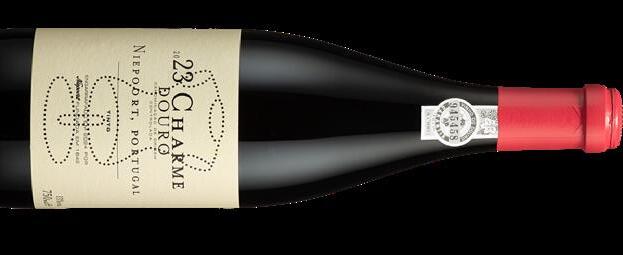
Tell us about some of your most popular wines in the UK. With Tiara, the idea was always to make something superfresh. When my father first made it in 2004, he was inspired by Riesling. It was in a Riesling bottle with 100% stainless steel and no malolactic. But in 2012 he changed the style completely, keeping the idea of freshness but with malolactic completed and ageing in big old foudres. We didn’t want any new wood here. Coche, on the other hand is a very different idea, the inspiration coming from Burgundy – but of course without Chardonnay. It’s a wine where we accept new oak but without the feeling that you’re drinking a piece of wood when you have the wine. Charme was again inspired by Burgundy. My father wanted to make a wine like Burgundy, in a place that’s nothing like Burgundy and without Pinot. It only macerates for two days before going into barrel. It’s extremely elegant. Because it was so innovative, at the time people would laugh at my father and joke around calling it a rosé. Today it’s even more delicate than it was back then. Batuta, on the other hand, was originally inspired by Bordeaux, even though today it’s nothing like Bordeaux. It’s one of the most challenging to make. The vineyard is over 100 years old; we do a long fermentation with some ageing in new wood, but it must be integrated. It has lovely tannins, lots of length and special ageability without being over-extracted. It takes a lot of time for us because it’s one of the hardest to get exactly how we want.
What about Nat’Cool, your “no rules” project?
I love it. You know, sometimes the wine world can be super snobbish and too serious. And of course, it’s OK to be sophisticated and special from time to time but wine can also be way less complicated and more cool. So that’s the idea. Making something very light, drinkable with low extraction and low alcohol to create a movement for younger people to not just drink wine, but drink quality wine without being too serious.

Despite red wines making up 80% of Dão production, some of Portugal’s finest and most ageworthy whites also hail from the region. It’s enclosed by granite mountains, and vineyards weave in between dramatic pine forests at altitudes of up to 1,000 metres.
The mountain ranges protect the region from the harshest of surrounding weather patterns and, despite having relatively high rainfall, most of it comes in the winter. Here, as in the Douro, soils are poor, but made up of sandy granite, again allowing roots to penetrate deeply in the search for water.
But in the Dão producers are moving away from field blending, despite its historically significant influence in the region. They want to focus on more precise, varietaldriven winemaking, often expressing the highly regarded local Encruzado grape with support from Bical, Cercial and Malvasia Fina. As a result, field blends are becoming rarer, with many producers sharing the
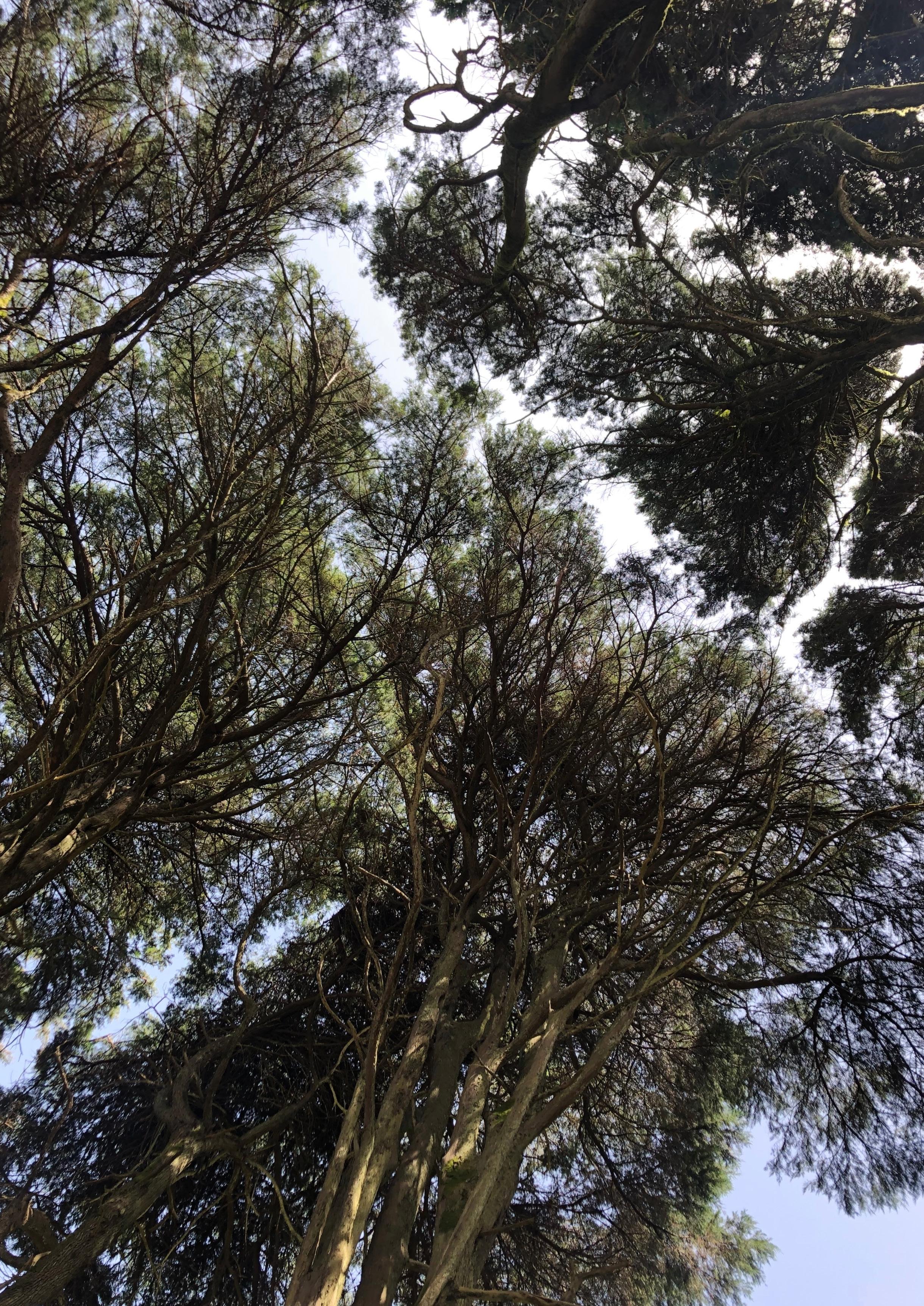
opinion that they inhibit quality and transparency.
And you can’t argue that growers are right to prioritise Encruzado; it is a charismatic variety with excellent ageing potential. And as the wines age, they develop a subtle resinous, cedary quality that recalls the forests that share the landscape with the vines.
Wines are processed in various ways, but higher quality wines will see some oak, at varying levels of neutrality. Malolactic fermentation and lees influence are common. When deft winemaking pairs with high quality fruit, these wines, as in the Douro, can be very Burgundian: silky and rich, with layers of complexity.
Only 15%-20% of Dão wines are currently exported. That figure stands a good chance of rising, especially with many established French rivals becoming increasingly unaffordable. Vinho branco is in a great position to stake its claim.
Vallegre is proud of its deep Douro roots, but has always been firmly focused on the future.
The wines are imported in the UK by Lanchester Wines. Find out more at lanchesterwines.co.uk
With a winemaking history dating back to the 19th century, Vallegre leans on five generations of knowledge and wisdom. Rooted firmly in the heart of the Douro, its heritage lies in one of industry’s most breathtaking landscapes. Dramatic and unspoilt, a love and respect for the Douro’s natural beauty is at the core of the Vallegre ethos.
Its important role in port production is symbolic of the rich wine history in the Douro, a unique style of wine that truly speaks of a place and time. But with an eye on the future and an understanding of demand, Vallegre proves that port isn’t the only way to express the magnificence of this landscape.
Vallegre’s range of still wines embodies its commitment to modernisation and creativity.

Vallegre is proud of its tradition and heritage but also works hard to future-proof its business. This has prompted many initiatives in the vineyard that aim to mitigate the threats of a warming climate. Even though Vallegre has never practiced irrigation, preferring to stress its vines, it recognises that in the future this may not be possible, and that preparation is essential.
Vallegre uses cover crops like legumes in the vineyards to improve soil health and benefit pollinators. Plans for solar installation and packaging reforms are also underway to help improve sustainability. It is working towards obtaining the Sustainability Seal, promoted by ViniPortugal, aligning with the National Sustainability Certification Standard for the wine sector.
This commitment reflects the company’s dedication to sustainable and credible practices. This is in addition to huge winery renovations in recent years to respond to the demands of the market, and improve quality, capacity and flexibility. It’s all with aim of making Vallegre a business that can lead the charge for Douro wines for the next five generations.
Feature produced in partnership with Lanchester Wines
Colheita Branco 2024: Vibrant and refreshing. It’s delicately floral with a citrus backbone; a thirst-quenching wine that signals the joy of Douro whites, even at entry level.
Colheita Tinto 2023: The familiar faces of Touriga Nacional, Touriga Franca and Tinta Roriz are all at work here for this typically smooth, generous Douro red. Think blackberries and plums with a subtle spice.
Reserva Especial Branco 2020: This is showing the more serious, sophisticated side of Douro Branco. Hailing from old vineyards on the platforms of the Baixo Corgo, this wine sees pre fermentation skin maceration, barrel fermentation and 12 months in French oak with regular batonnage, resulting in a wine with sumptuous texture and complexity.
Old Vines Reserva Especial Tinto 2020: Over 100-year-old vines on south-facing terraces produce the fruit for this full-throttle Douro red, soulful and sun soaked with fistfuls of gorgeously ripe fruit. The wine is bottled unfiltered after 22 months in new French oak. Dark chocolate, spice and vanilla are all present here with a persistent structure that promises a long future.
Quinta de Valle Longo Reserva 2016/17: A Touriga Nacional-led blend from Vallegre’s estate in Longo Valley, where vineyards are traditionally terraced on the steep banks of the river. This is luscious and perfumed with ripe red plum, blackberry and delicate floral hints. The balance of fruit depth and oak influence is well integrated with a long, indulgent finish.





This will be the region’s first trade and press tasting in London for several years.
Featuring 23 Portuguese producers and more than 200 wines, the event will include a free-pour area with wines under 11.5% abv, single varietal wines from native grape varieties and lower intervention/sustainable wines.
There will be two masterclasses hosted by Dirceu Vianna Junior MW.
10am to 11.30am: The ambitious, diverse and contemporary styles of Vinhos Verdes 2pm to 3pm: Monção & Melgaço, where ambition and diversity meet.
Registration is required for both the tasting and the masterclasses by emailing vinhosverdes@thewineagency.pt.
Monday, June 2
Church House Westminster London SW1P 3NZ
The tasting returns to Edinburgh after two successful years in London.
Taste more than 100 white wines from across the Rhône Valley spanning from Condrieu and Saint-Joseph to Vacqueyras and Luberon.
More than 20 appellations will be represented, covering price points from value weekday wines to premium white wines, plus some sweet and sparkling options.
For more information and to register contact sguillermin@hopscotchgroupe. com.
Wednesday, June 4
SKYBar Edinburgh
34 Bread Street
Edinburgh EH3 9AF
More than 25 key producers will attend, with visitors having the opportunity to meet the families behind the wines imported by the London merchant.
The Davy’s team will be introducing newcomers to the portfolio including up-and-coming southern Rhône producer Domaine de Piéblanc, and Nine Oaks Vineyard from Hothfield, Kent.
A free-pour area will offer rosé, sparkling and house wine options as well as feature tables: indie top 20, by-the-glass team picks and a “small is beautiful” selection of back vintages and “by allocation” parcels.
To register and for further details, email katyas@davy.co.uk.
Wednesday, June 4
Royal Over-Seas League 6 Park Place London SW1A 1LR
Explore the wines that have put Australia and New Zealand in the spotlight and discover new styles that are coming out of both countries.
There will be 70 wines to taste across the day: minimal intervention and natural wines, organic and biodynamic wines, new wave styles and alternative varieties including Albariño, Fiano, Zibbibo, Barbera, Montepulciano and Uva di Troia.
The focus will be on regional and stylistic differences and exploring winemaking techniques of the future. All of the wines featured are available in the UK.
To register, contact uk@wineaustralia. com.
Monday, June 9
The Castlefield Rooms 18-20 Castle Street Manchester M3 4LZ
The California Wine Institute celebrates Zinfandel with an evening of fire grilling and country music.
This event marks the launch of the Zin and Grill Campaign and is organised with indies very much in mind. The wines poured will include lighter chillable styles through to rich and round Zins.
For more information and to register email nladwiniec@wineinstitute.org.
Thursday, June 12
Location upon RSVP

Taste all styles of Zin on June 12
The event returns for its third year and promises to be the biggest so far.
Attendees can taste more than 120 oldvine wines from across the world and meet with producers through a series of themed masterclasses.
Registration can be requested by emailing belinda@oldvines.org.
Tuesday, June 17
Vagabond Wines Monument 51 Gracechurch Street
London EC3V 0EH

New Bank House
1 Brockenhurst Road
Ascot
Berkshire SL5 9DL
01344 871800
info@hatch.co.uk
www.hatchmansfield.com

@hatchmansfield

Diogo Sepúlveda has been at the winemaking helm at Quinta de Azevedo since 2022, overseeing the release of this historic estate’s first oak-aged wines last year. Made with the two star indigenous varieties of the Minho region in northern Portugal – Alvarinho and Loureiro - these are gastronomic, textured whites from 100% estategrown fruit and with a real sense of place.




The vineyards are planted on schist/clay soils – a rarity in a region where granite soils predominate –and located just 20km from the Atlantic coast. This combination of warmer soils and cooling sea breezes allow the grapes to ripen more evenly, fully, and earlier, producing white wines of remarkable depth, complexity, and ageworthiness.
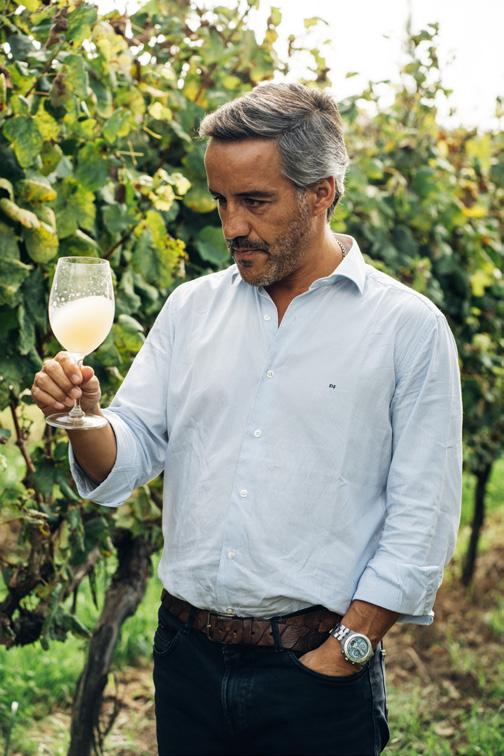
The Alvarinho Escolha 2023 and Loureiro Escolha 2023 are 15% aged in used French oak barrels for six months, displaying signature freshness and precision coupled with a creamy texture. The 2022 Torre Grande Escolha (Grand Selection) is a 70% Alvarinho/30% Loureiro blend of the estate’s best grapes. Eighty percent aged in large format French oak casks for eight months, it is a wine of great aromatic intensity, structure, and elegance.
buckingham schenk
Unit 5, The E Centre
Easthampstead Road
Bracknell RG12 1NF
01753 521336
info@buckingham-schenk.co.uk
www.buckingham-schenk.co.uk


@BuckSchenk
@buckinghamschenk


boutinot wines
Boundary House
Cheadle Point
Cheadle SK8 2GG
0161 908 1300
www.boutinot.com
Scan the QR code to register for our English Wine Week activation pack including T-shirts, posters, tote bags, tent cards, ice bucket, bottle wrap and stickers. Open to Boutinot customers only. T&Cs apply



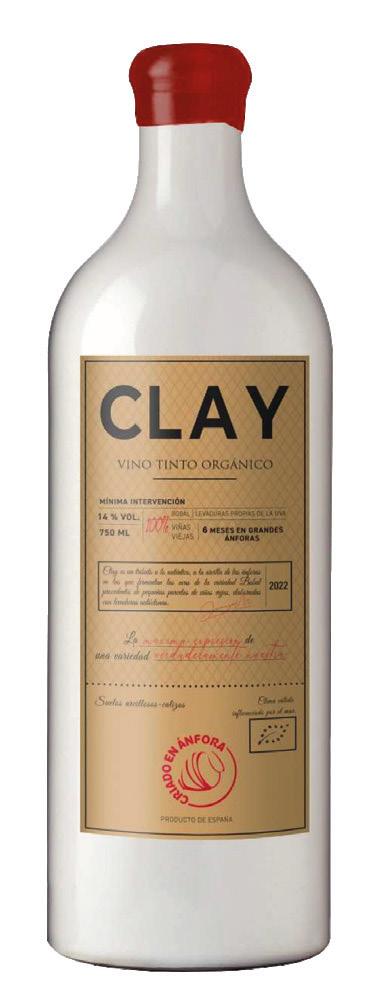

Win £500 free stock + travel, accommodation & winemakers tour for up to 4 staff members!
Across the Month of June Henners are launching our biggest ever English Wine Week activation with Boutinot partner & consumer competitions.
Promote Henners in store & on social media, and the most creative retail campaign will win a Henners stock & trip bundle, while your customers are also in with a chance of winning a winemaker tour with accommodation.
The Woolyard 52 Bermondsey Street London SE1 3UD
020 7840 3600
info@mentzendorff.co.uk
www.mentzendorff.co.uk


Arguably Portugal’s greatest modern success story, the wines of Vinho Verde have exploded in popularity, largely thanks to its public image as a fresh, go-to sipper and easy-drinking reputation.


But the wines of Vinho Verde are capable of so much more! With the recent acquisition of Quinta da Pedra, Fladgate (Taylor’s Port) now has a 53ha stronghold in the Vinho Verde region producing two delicious Alvarinhos.
Graça da Pedra - fresh, crisp and invigorating, a younger Alvarinho that’s designed for immediate enjoyment. Milagres - their “perfect” Alvarinho, released after 2-3 years ageing in bottle. Itis delicious to drink now but will continue to age beautifully for a further 10 years from the date of harvest.

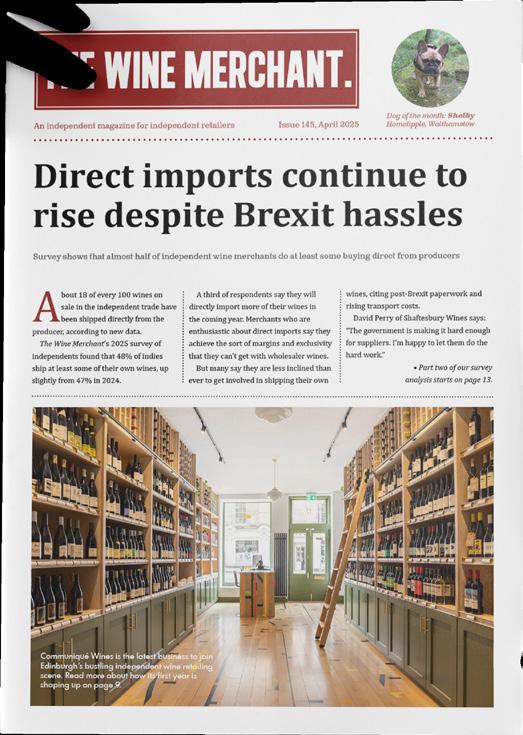



The Links, Popham Close Hanworth TW13 6JE 020 8744 5550
Mark Isham, south & London: mark@richmondwineagencies.com
Julia Langshaw, north of the UK: julia@richmondwineagencies.com
Tim Hawtin, south west & London: tim@richmondwineagencies.com
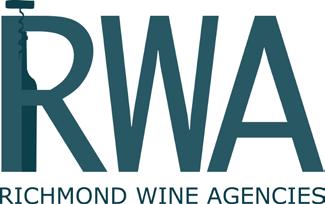

We are delighted to inform you that Marqués de Riscal Limousin 2023 has been awarded 96 points in the Tim Atkin Rueda 2025 Top 100 report, placing it among the most outstanding wines of the year. Beth Willard, the report’s author, describes this Gran Vino de Rueda as generous yet fresh, balancing richness with vibrant acidity, calling it a benchmark Gran Vino.
Finca Montico 100% Organic 2023 also received an excellent score of 95 points According to the author’s tasting notes, it is very pretty on the nose, and its six months of lees ageing result in a creamy texture and generous mouth feel.
Here’s to these two outstanding white wines!
109a Regents Park Road
London NW1 8UR
0207 449 1665
orders@walkerwodehousewines.com www.walkerwodehousewines.com


@WalkerWodehouse

Corpinnat producer Sabaté i Coca has joined the Walker & Wodehouse portfolio, with four of its flagship sparkling wines.
With an illustrious 125-year history, Sabaté i Coca is located in the historical Bittles River Valley in the Penedès region. Fourthgeneration vine growers, brothers Josep and Marcel, now run the estate, embracing what they call “a holistic approach” to winemaking. Their brand symbol, a butterfly, signifies their respect for the biodiversity of the environment.
In January 2019, they broke away from Cava appellation, along with five other producers, to create Corpinnat, a collective EU brand created to promote quality, where all wines are made under the traditional method, are hand harvested and made from 100% organic grapes. Their sparkling wines are exceptional expressions of the traditional sparkling wine grape varieties and showcase Josep and Marcel’s love for the land on which the grapes are grown on.
For more information, please contact your account manager.

Fells House, Station Road
Kings Langley WD4 8LH
01442 870 900
For more details about these wines and other wines from our awardwinning portfolio from some of the world’s leading wine producing families contact:
info@fells.co.uk www.fells.co.uk

@FellsWine

je_fells
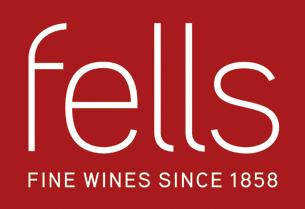
12-14 Denman Street
London W1D 7HJ
0207 409 7276
enquiries@louislatour.co.uk www.louislatour.co.uk

@louislatouruk



Maison Louis Latour, founded in 1797, is a distinguished family-owned winery located in Burgundy. The Latour family has been cultivating vineyards since the 17th century, amassing an exceptional collection of 50 hectares, including the largest holding of Grand Cru vineyards in Burgundy. Their estate encompasses renowned sites such as CortonCharlemagne, Romanée-Saint-Vivant, and Chevalier-Montrachet.
The historic Corton Grancey Cuverie, constructed in 1834, serves as the heart of their winemaking operations. This gravity-fed winery, the first of its kind in France, exemplifies their commitment to traditional technique. Under the guidance of domaine director Christophe Deola, Maison Louis Latour continues to produce wines that reflect the unique terroir of Burgundy, blending heritage with innovation.
For more information, please contact sales@louislatour. co.uk or scan the QR code.

hallgarten wines
Mulberry House
Parkland Square
750 Capability Green
Luton LU1 3LU
01582 722 538
sales@hnwines.co.uk www.hnwines.co.uk



@hnwines

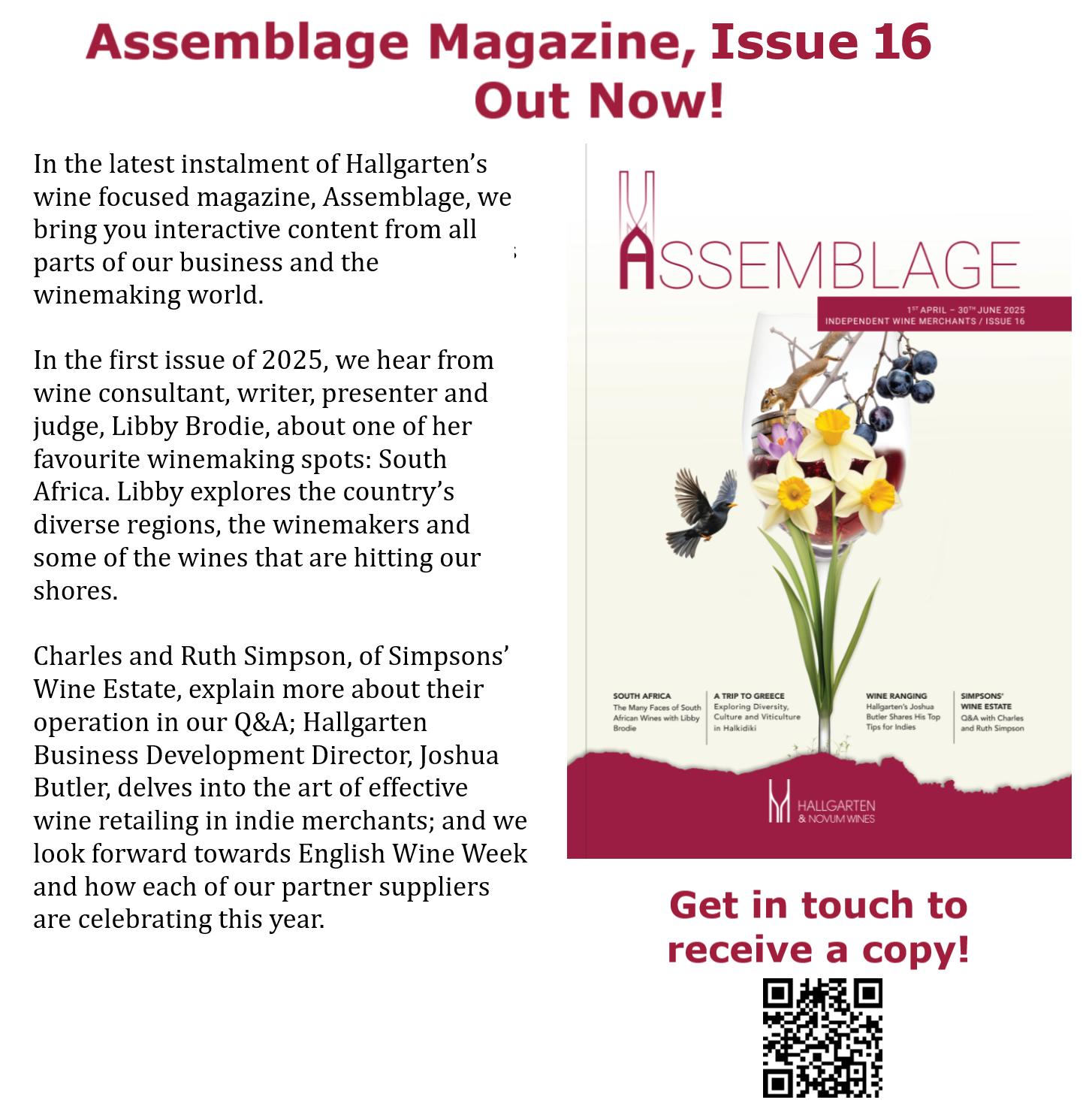
top selection
23 Cellini Street
London SW8 2LF
www.topselection.co.uk info@topselection.co.uk
Contact: Alastair Moss
Telephone: 020 3958 0744


@topselectionwines
@topselection

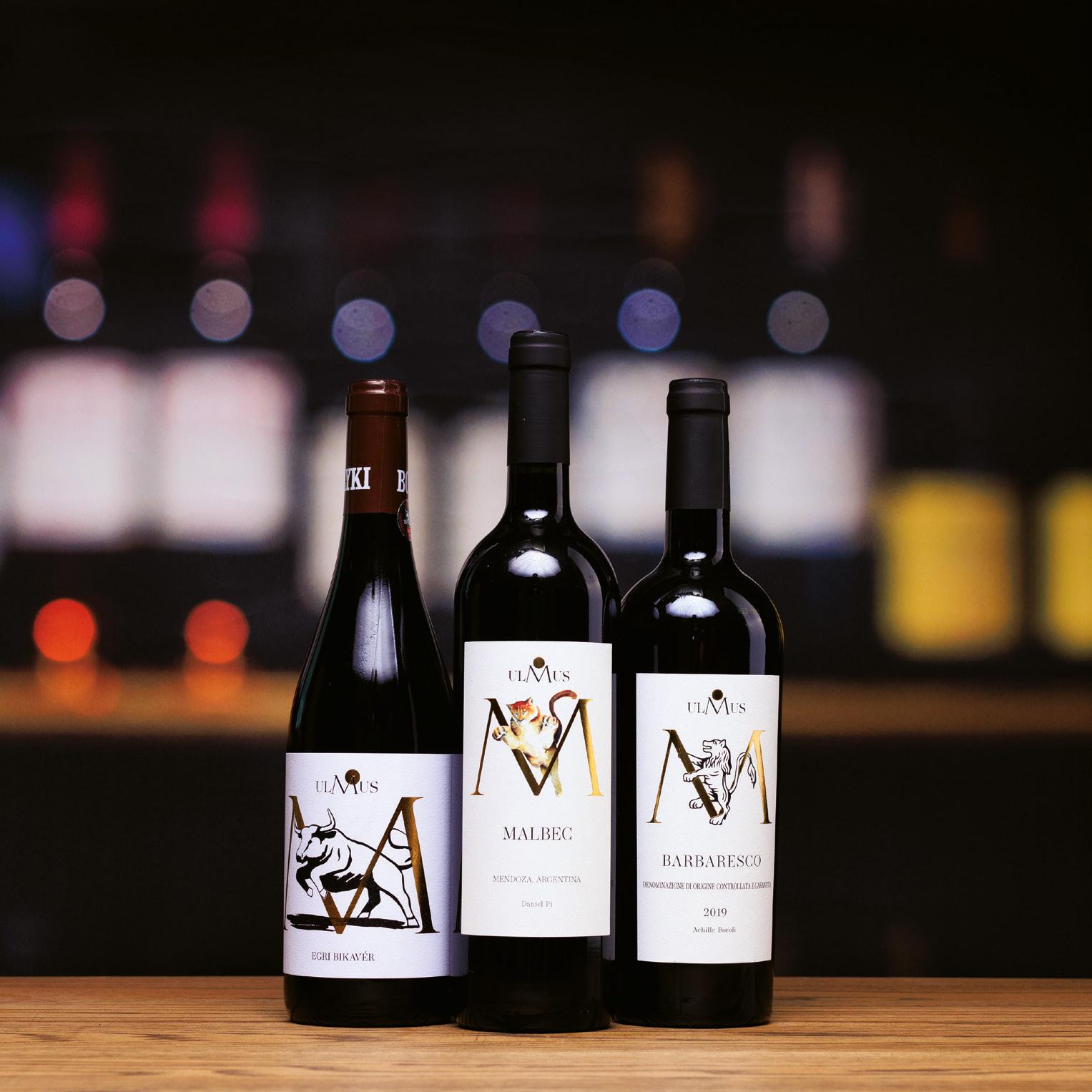
Developed in collaboration with some of the world’s most respected winemakers to embody the spirit of discovery and excellence that defines Top Selection
“I am related to a staggering number of people on Mersea Island”
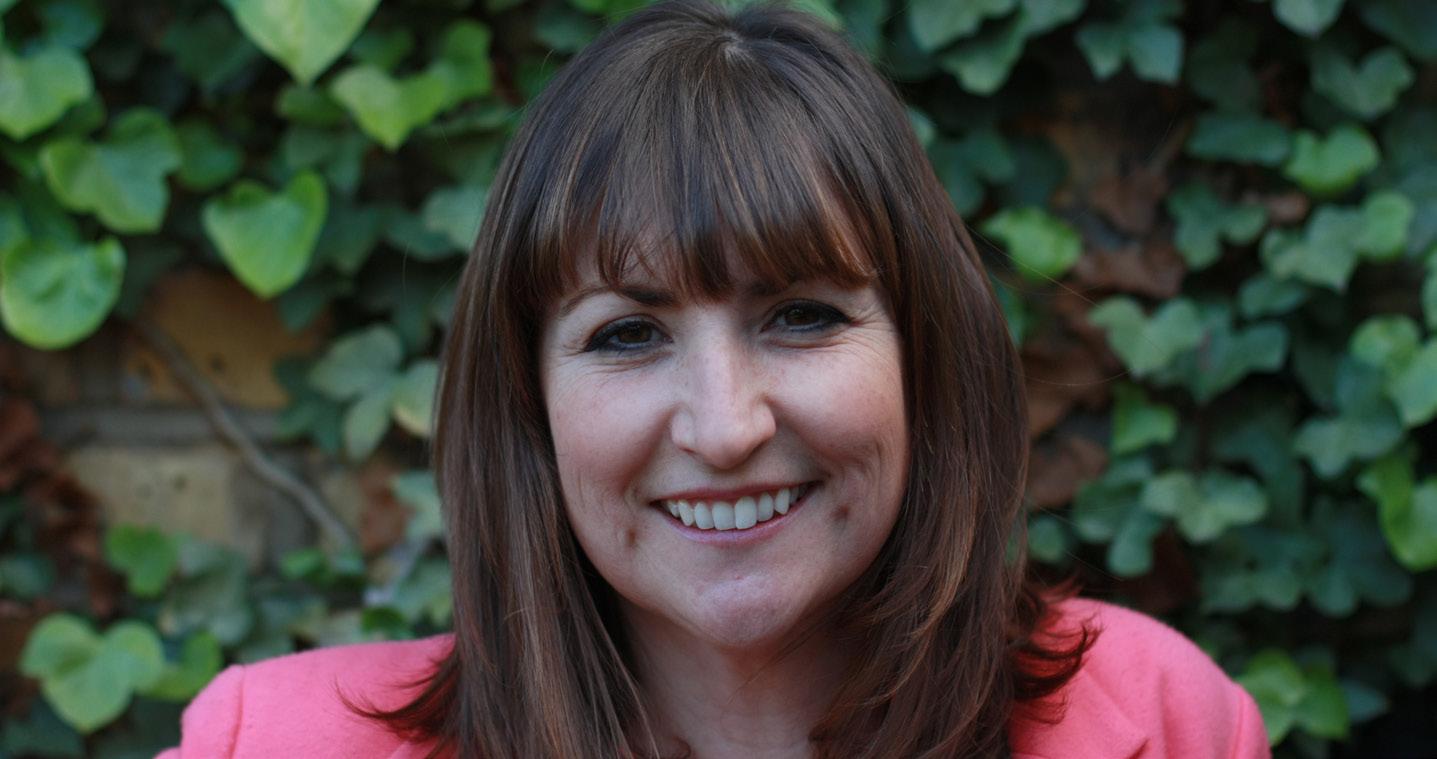
Originally from Warwickshire, Hannah started her career at Decanter before taking senior roles on a range of magazines including Wine and Imbibe. She has been running the London Wine Fair since 2018.
What’s the first wine you remember drinking?
My dad and my uncle always spent a huge amount of time talking about and tasting wine, as far back as I can remember. They would often bring a covered bottle to dinner and enjoy watching the other try to guess what it was. I have no idea when I would have had my first sip, or taste, but I’m told I’ve always liked it. My first real “penny drop” moment as an adult was being lucky enough to experience a sevencourse tasting menu at Launceston Place in my early 20s. They had paired the veggie appetiser, which included a sort of nettle broth, with a fino sherry. It was a moment.
What job would you be doing if you weren’t in the wine trade?
I did a year abroad in Bordeaux, as part of a French degree. I worked as a teaching
assistant and absolutely loved it. I’m endlessly intrigued and often highly amused by how children’s minds work. So I would probably say primary school teacher. My mum was a teacher for over 40 years, so I appreciate that it isn’t an easy path!
How do you relax?
I have a full-time job, two energetic boys and a mad spaniel, so I don’t often. I walk my dog on Hampstead Heath, I do yoga and I sing in a choir. I suppose they are my most mindful activities.
What’s the best book you’ve recently read?
A Gentleman in Moscow. It is just wonderful. I like the following quote in particular: “For what matters in life is not whether we receive a round of applause; what matters is whether we have the courage to venture forth despite the uncertainty of acclaim.”
Give us a Netflix recommendation. Schitt’s Creek is endlessly delightful. I laughed and cried and could happily watch
it all again. If you haven’t yet watched it, give it a couple of episodes to bed in and you’ll be gripped for the whole six seasons.
Do you have any sporting loyalties?
I live half a mile from the Arsenal stadium and my boys are huge fans. So I guess it’s Arsenal by proxy?
Who’s your favourite music artist?
My husband is a DJ so it is very hard to pick one artist from all the tunes that get dropped at home. The weekend before last we went to see Sultan + Shepard live at Koko in Camden. Absolutely brilliant.
Any superstitions?
I don’t like walking over three drains together, but that’s probably more practical than anything else.
Who’s your favourite wine critic?
That feels like being asked to pick your favourite child. Surely not allowed.
What’s your most treasured possession?
A gold necklace that was a 21st birthday gift from my grandmother. She had it made from a Victorian watch chain.
What’s your proudest moment?
In my personal life I’m most proud of my two lovely boys. Professionally, probably steering LWF through the pandemic and running the world’s biggest-ever digital wine event in 2001. Two days, 28 sessions, around 250 exhibitors and 5,000 samples shipped. All organised from home in lockdown in under three months.
What’s your biggest regret?
I tend to say yes to as many things as possible, in order not to have regrets. So I’m more likely to regret the sheer volume of plates that I am spinning at any given time.
Any hidden talents?
I love snowboarding and am not too bad at it.
What’s your favourite place in the UK?
Mersea Island. I am related to a staggering number of its inhabitants and spend quite a lot of time there.
If we could grant you one wish, what would it be?
How about remove the strange orange man from power, over the pond?
